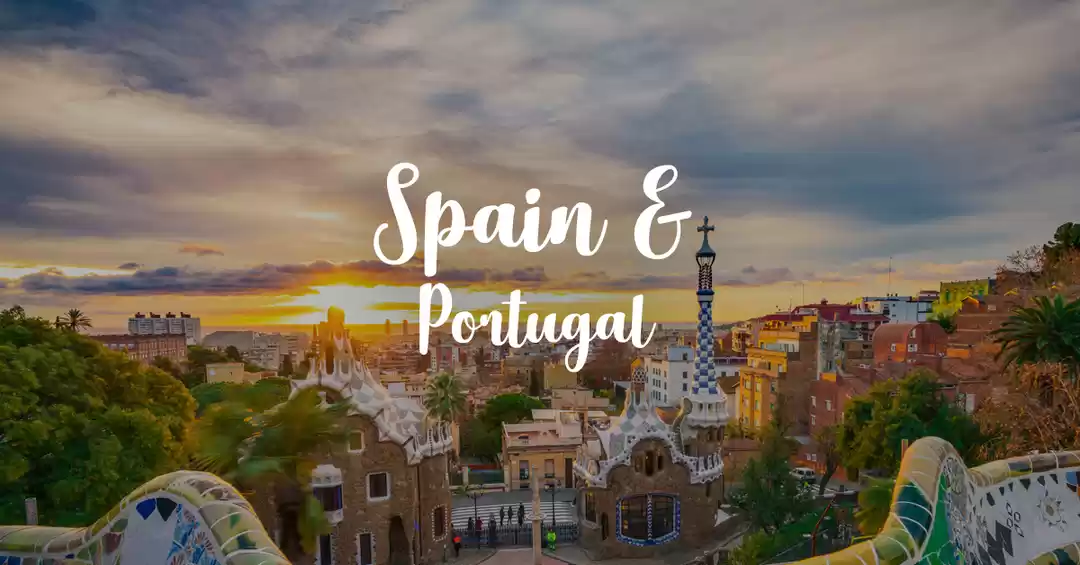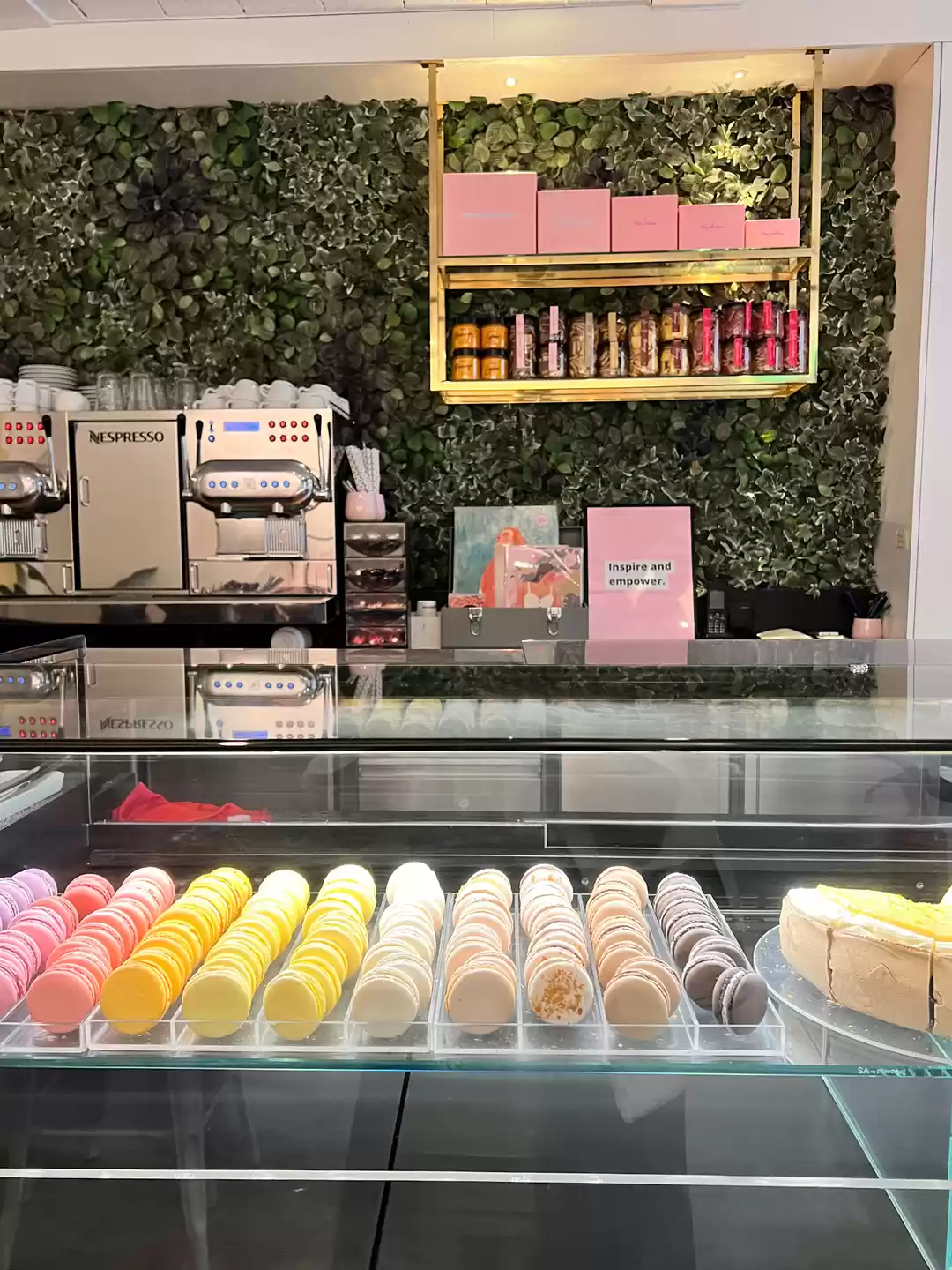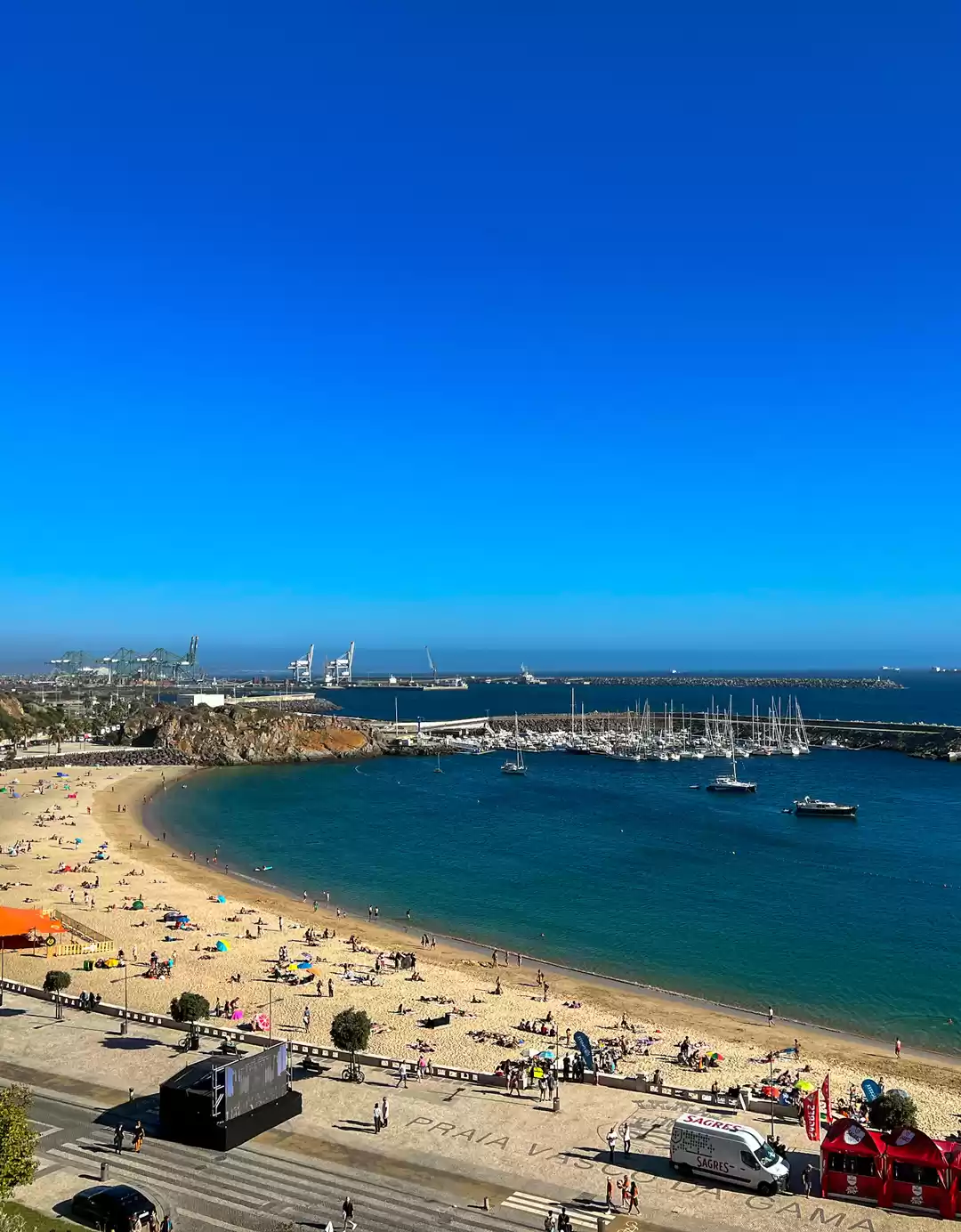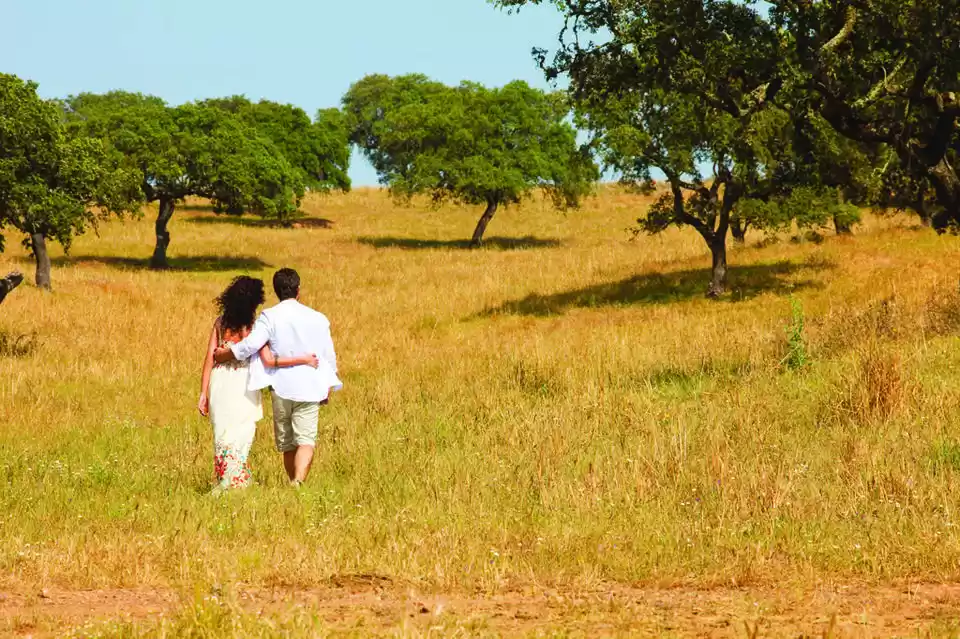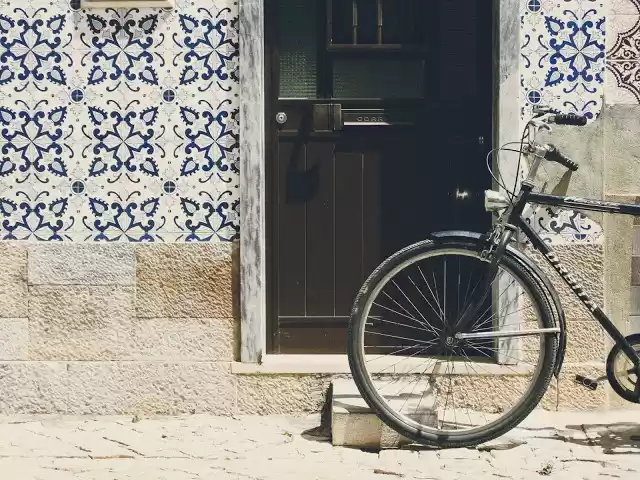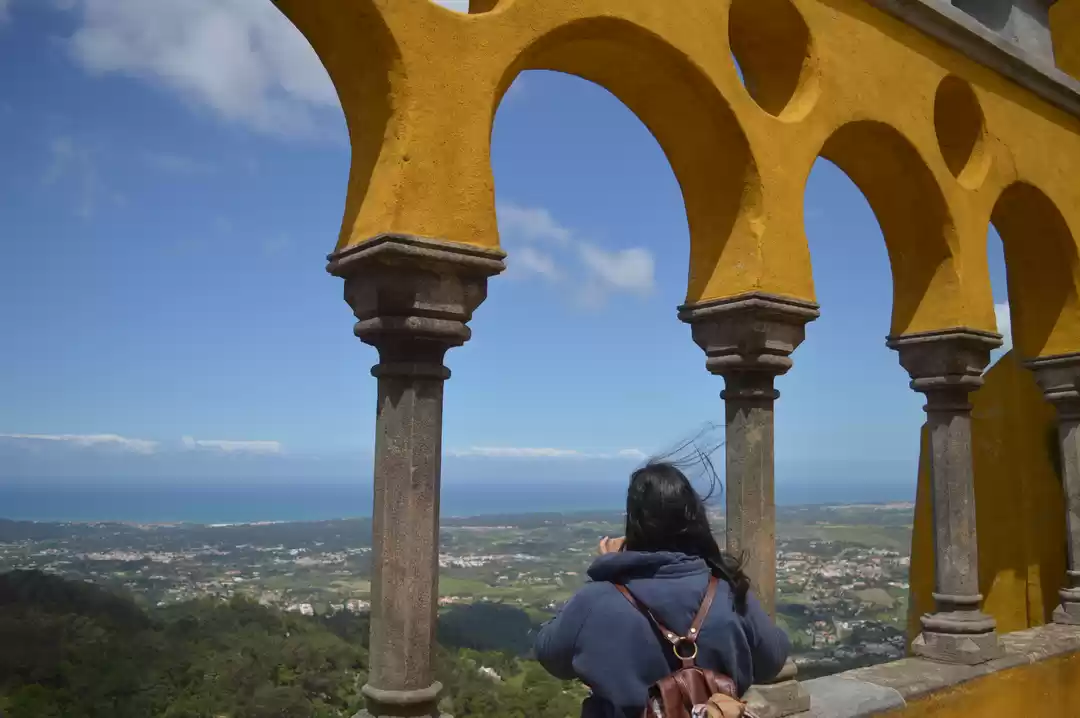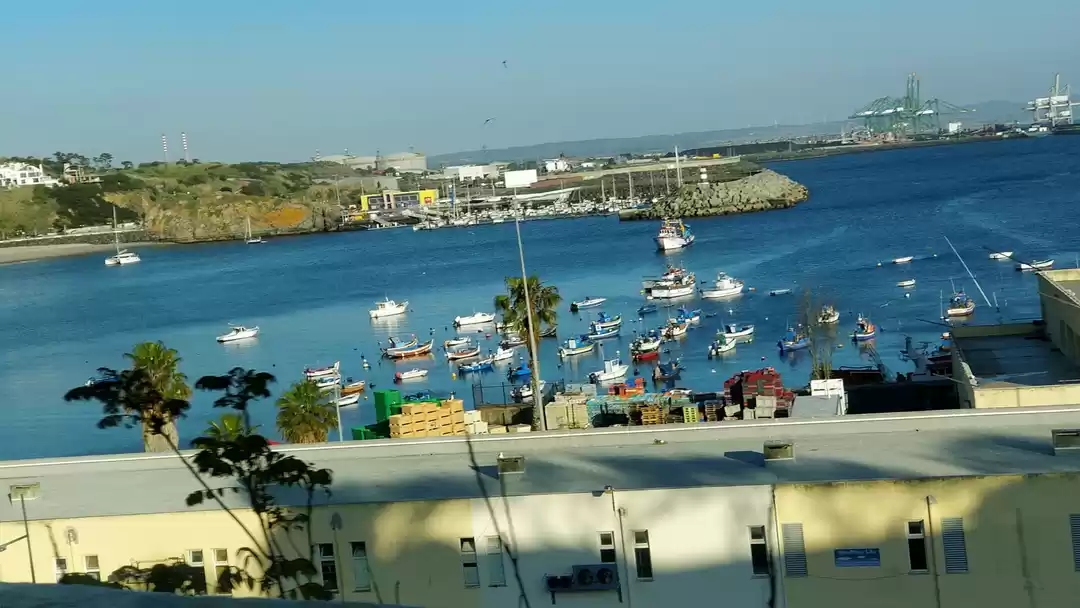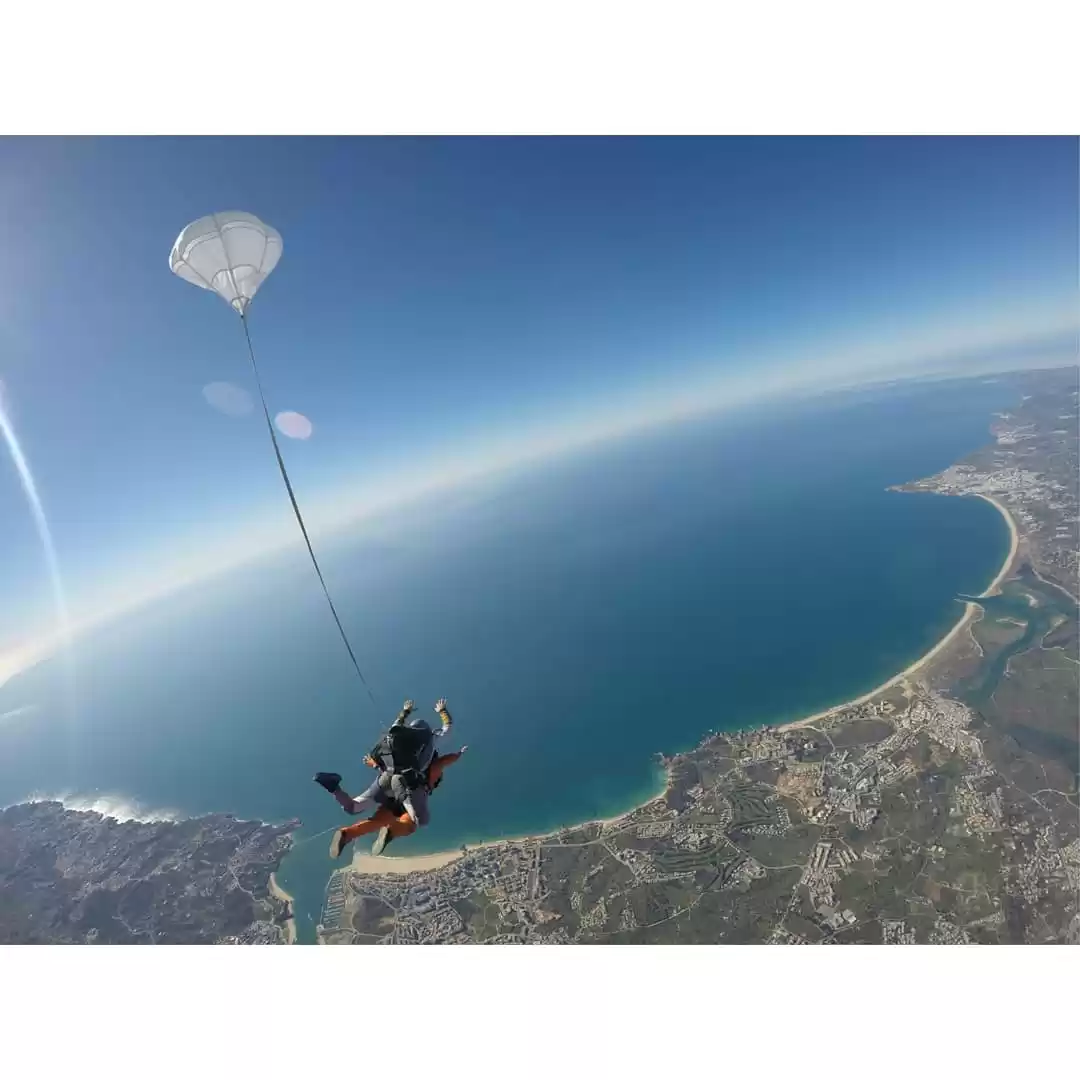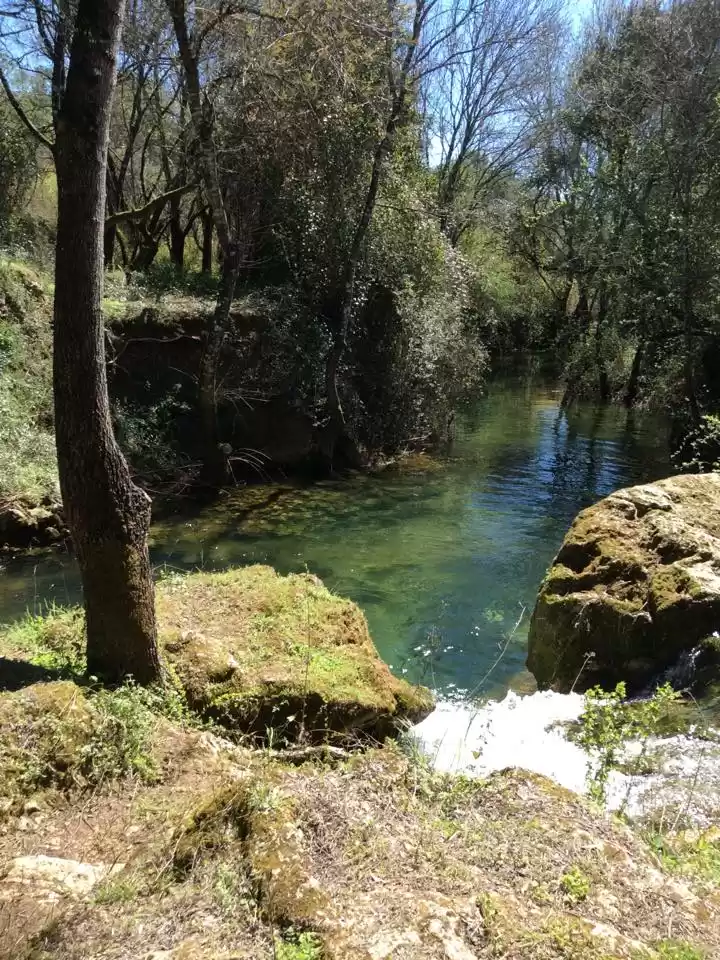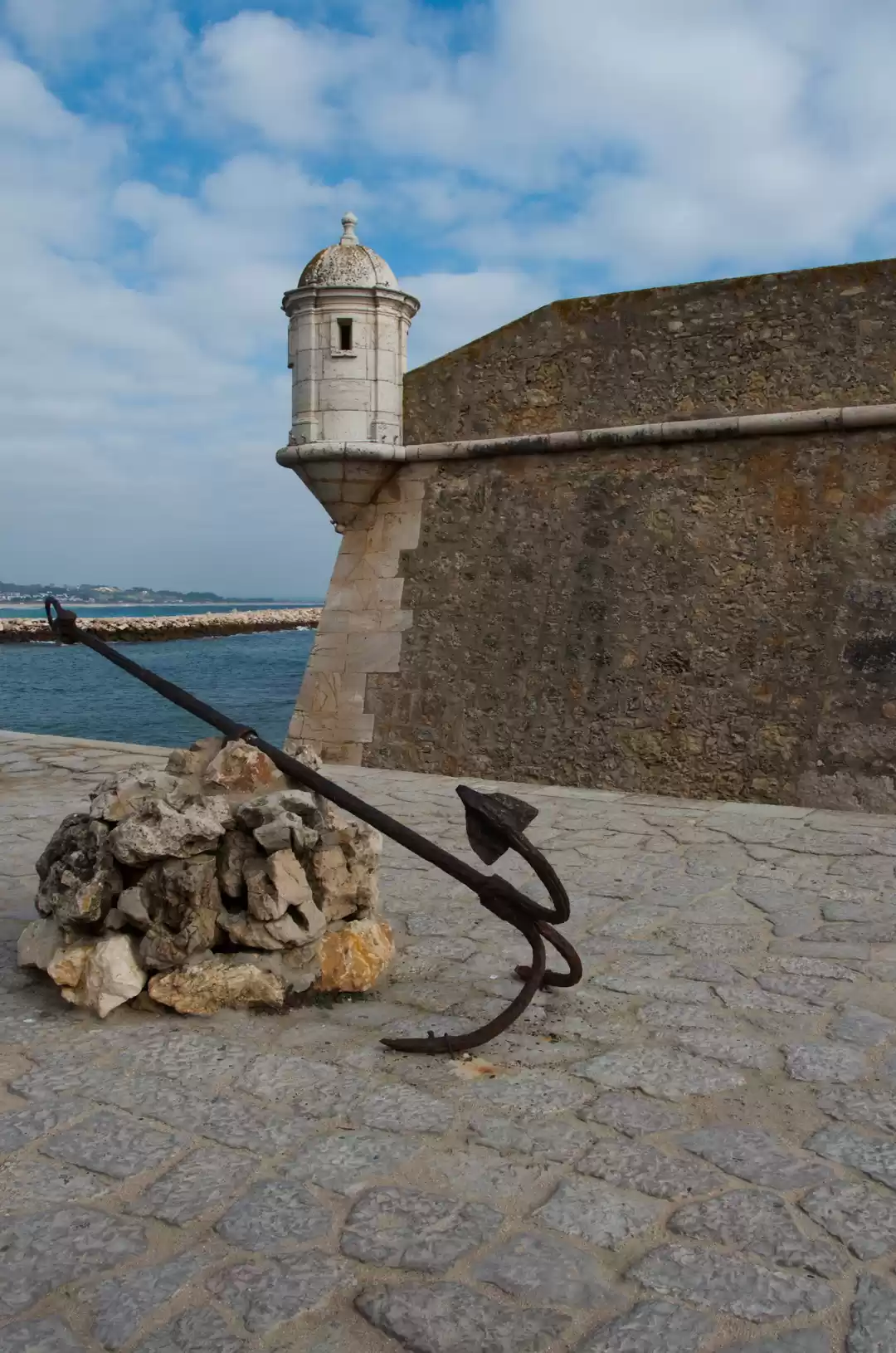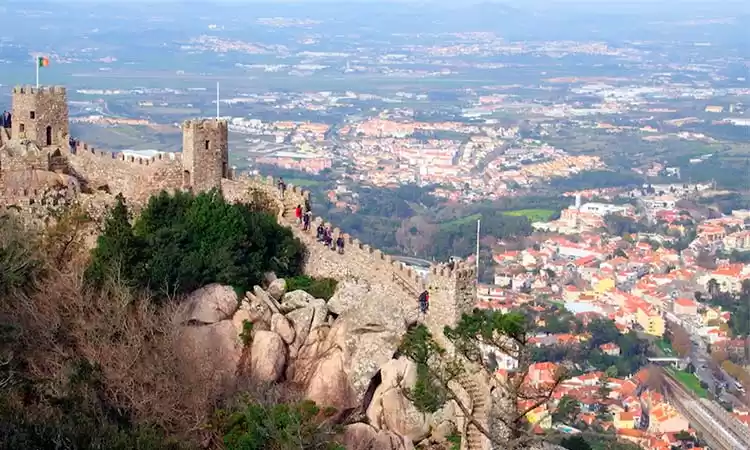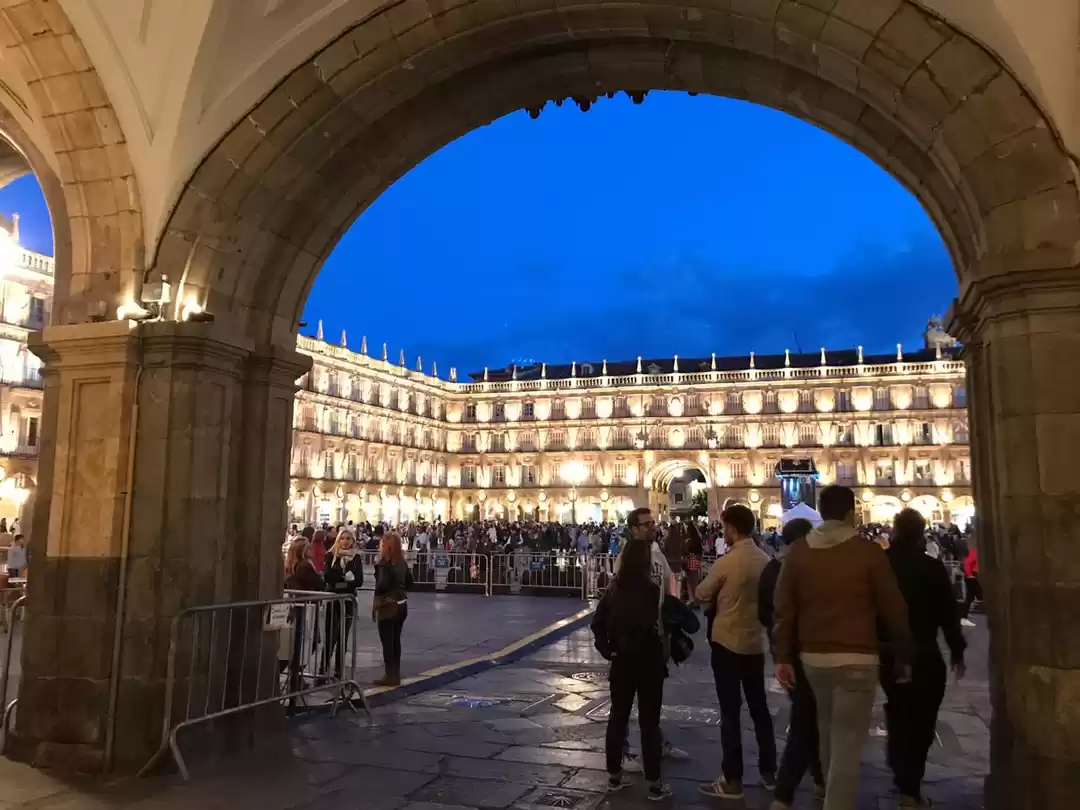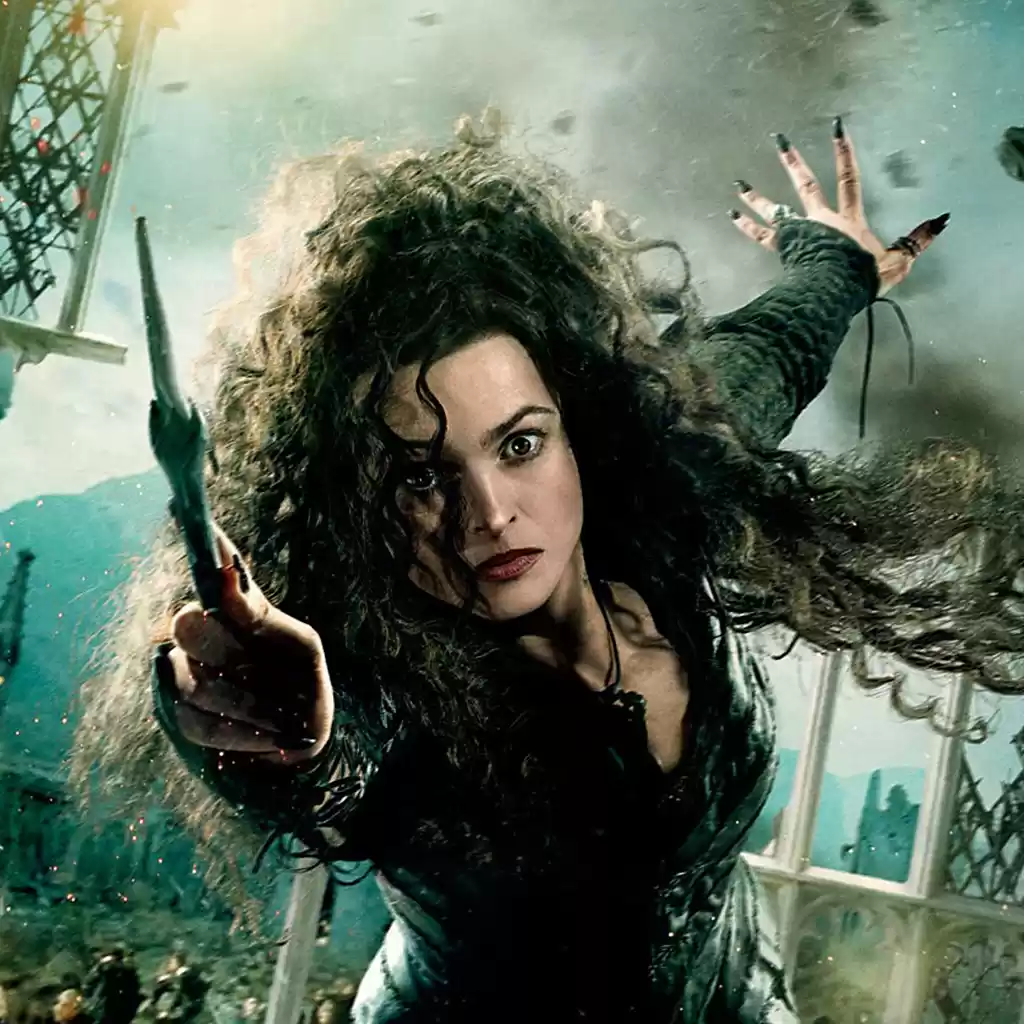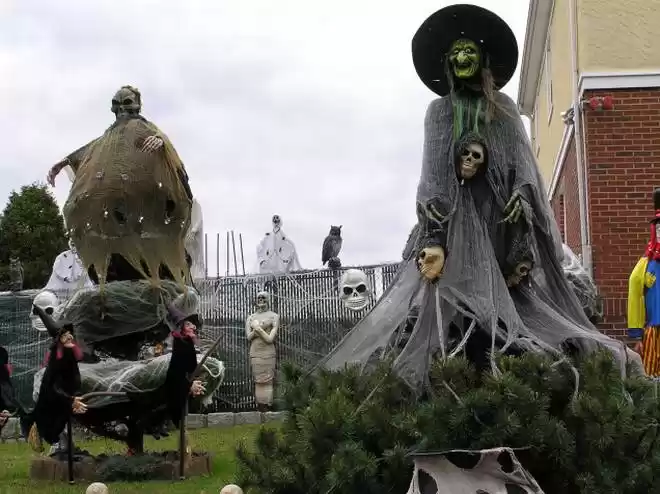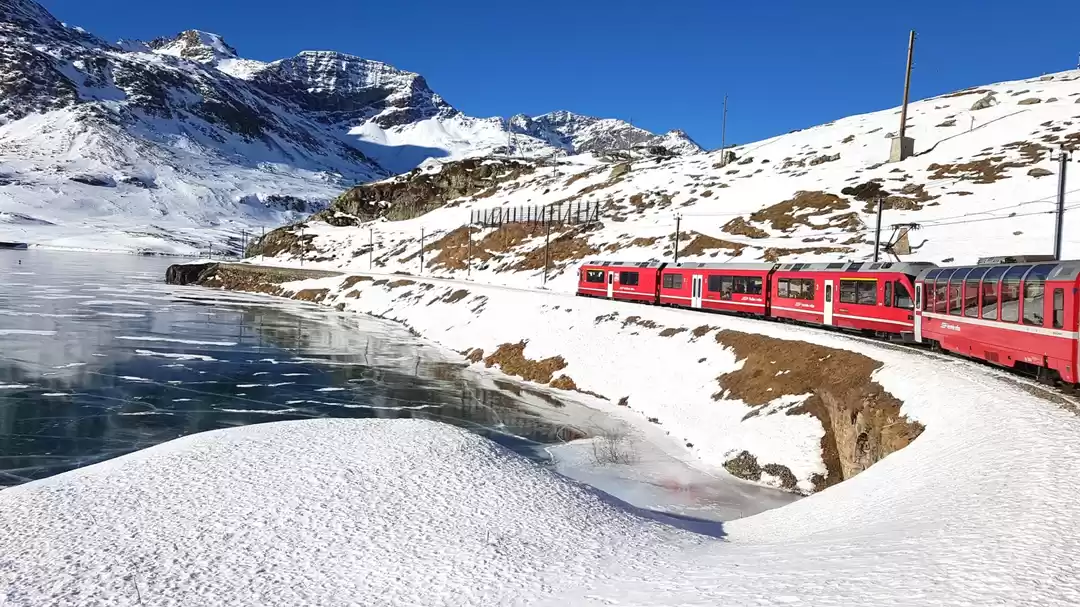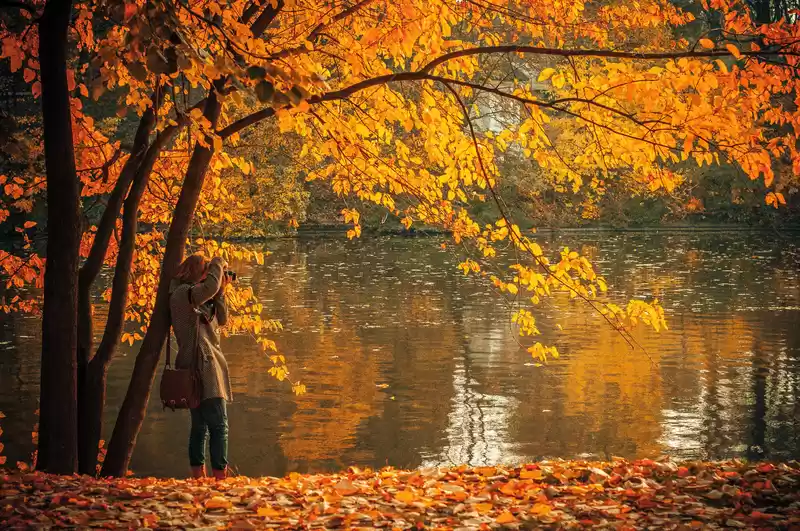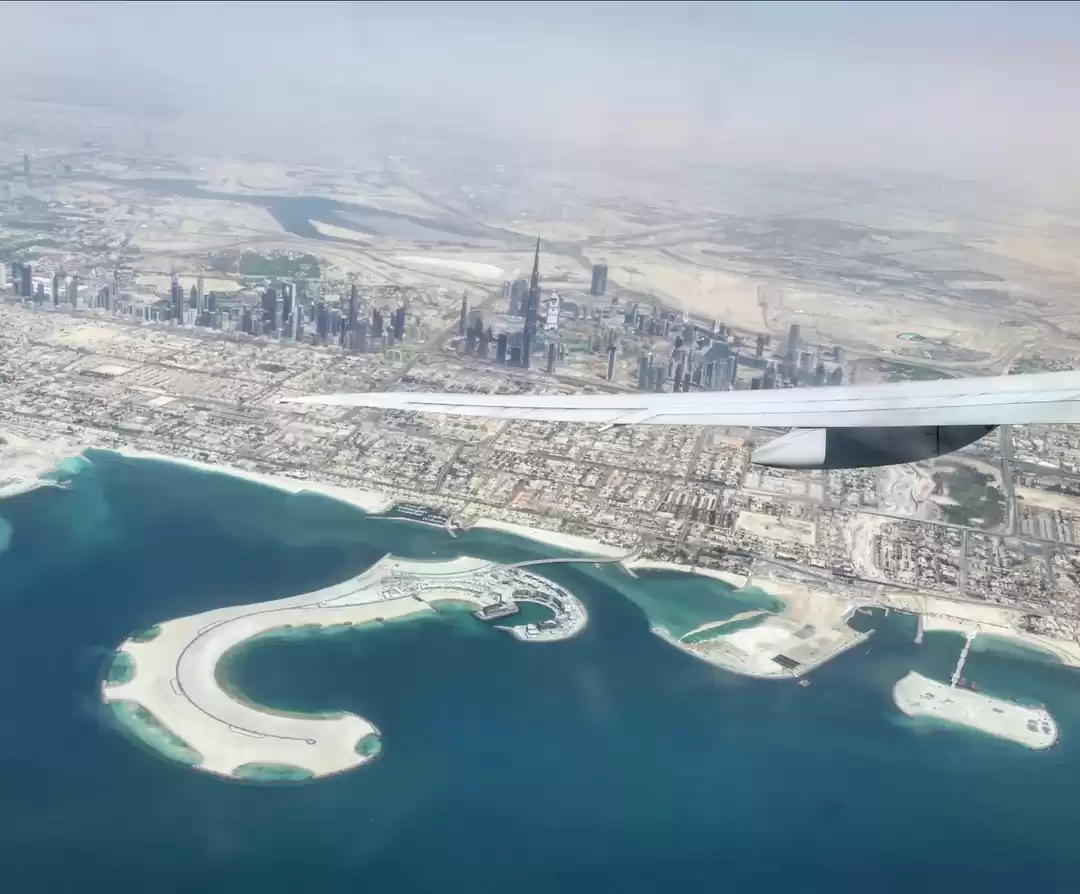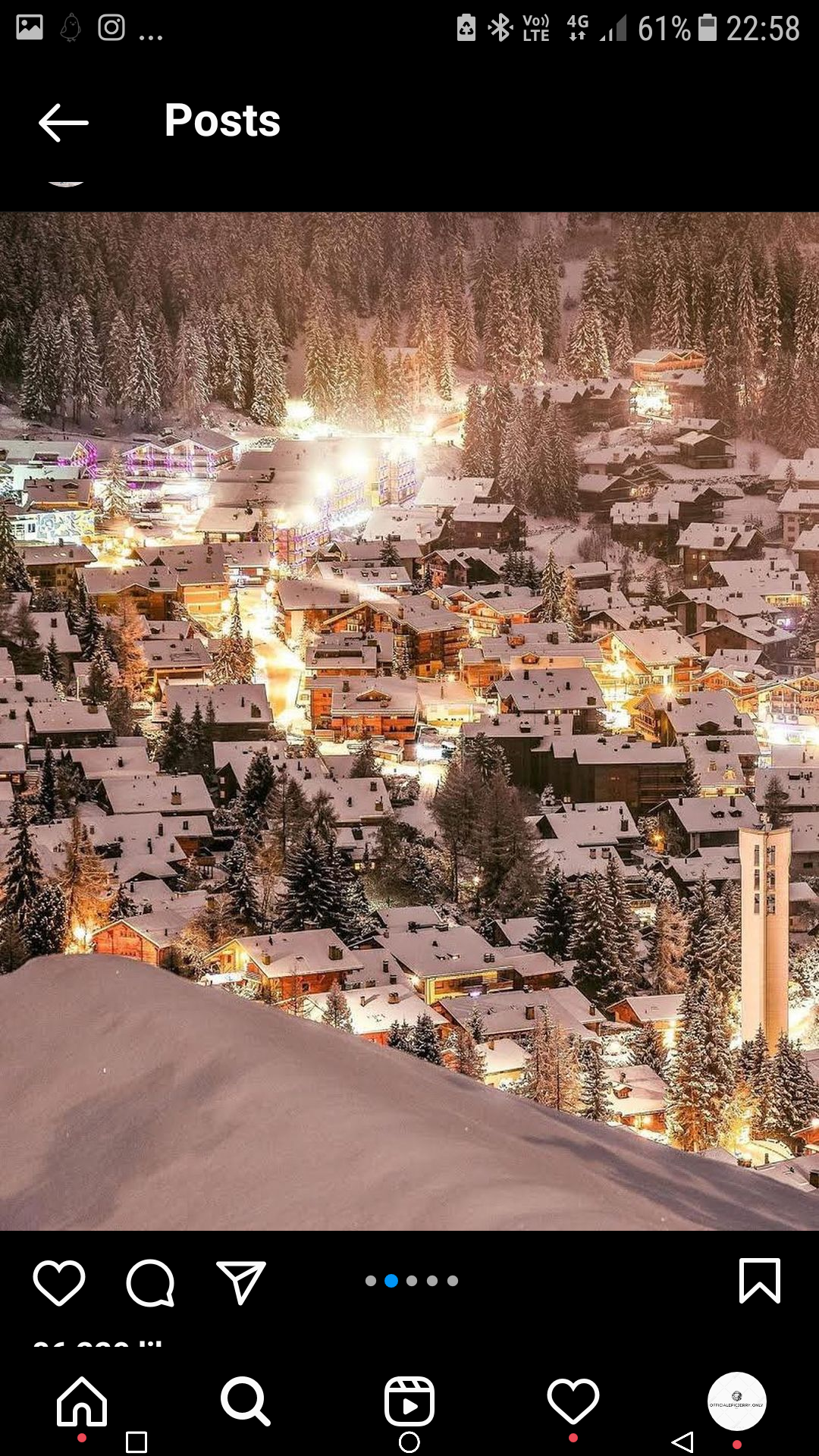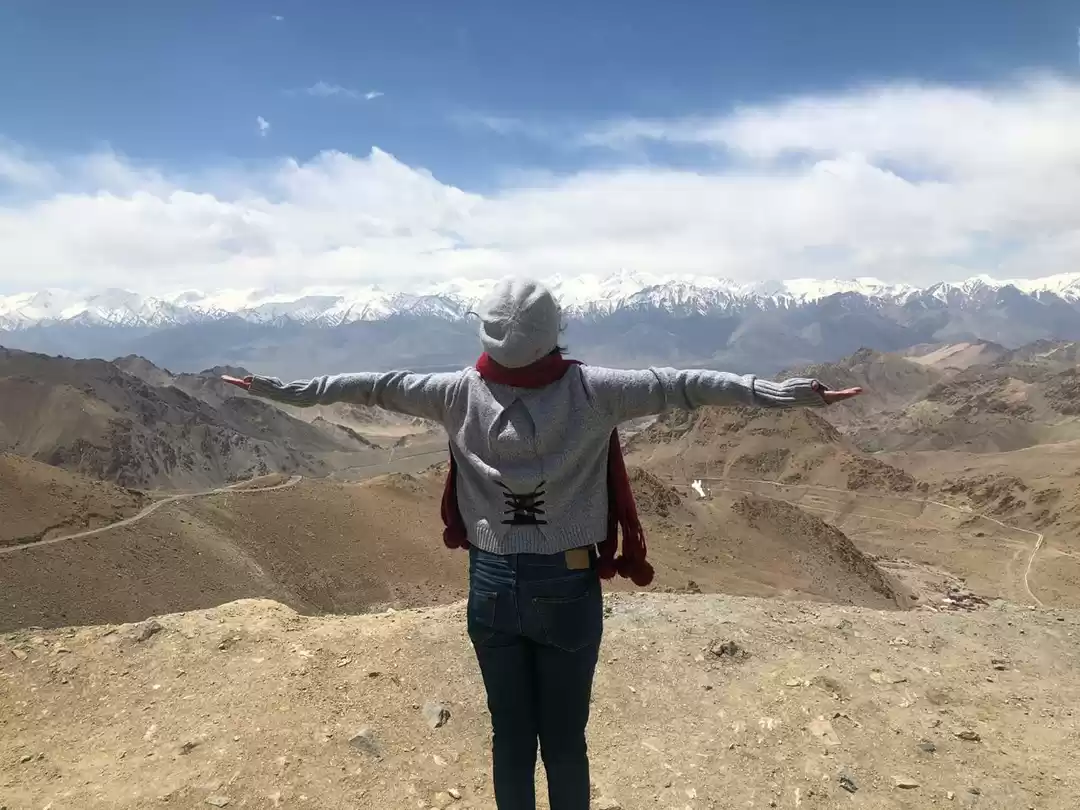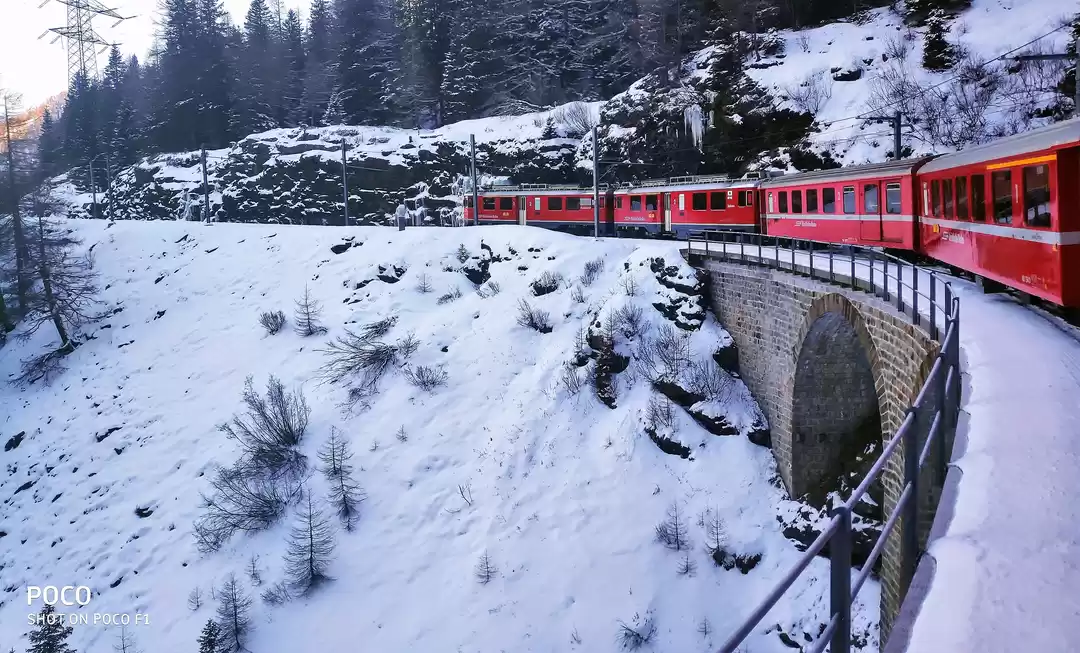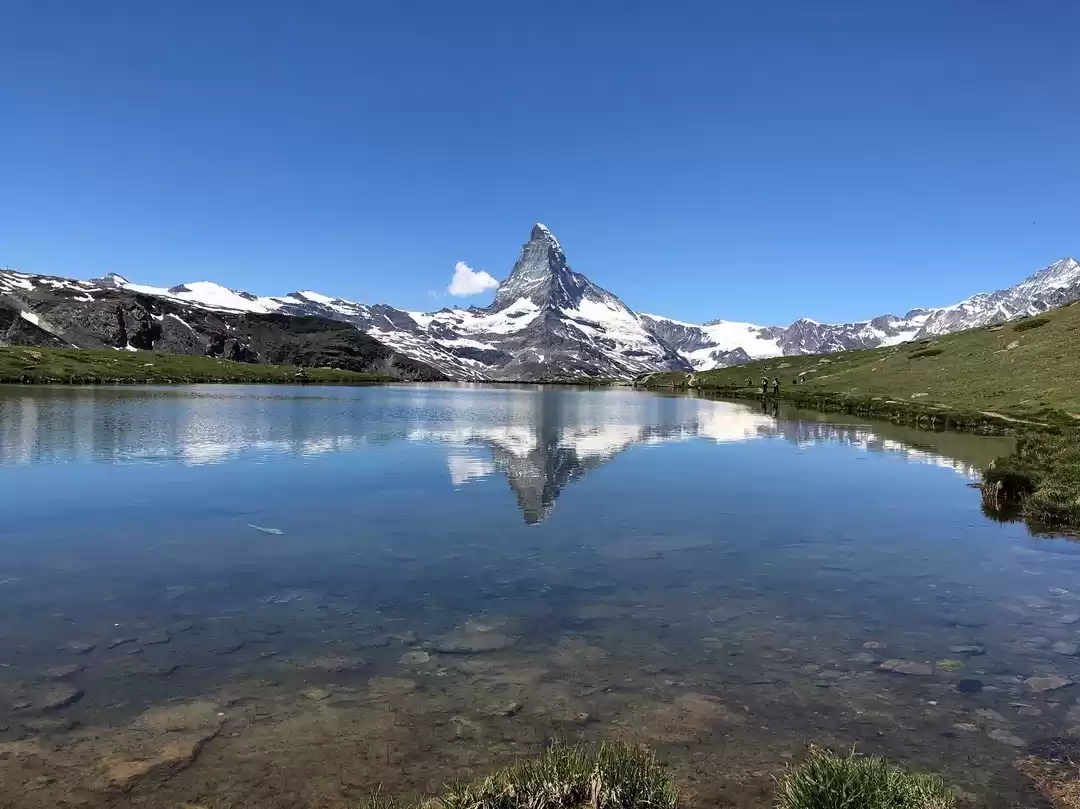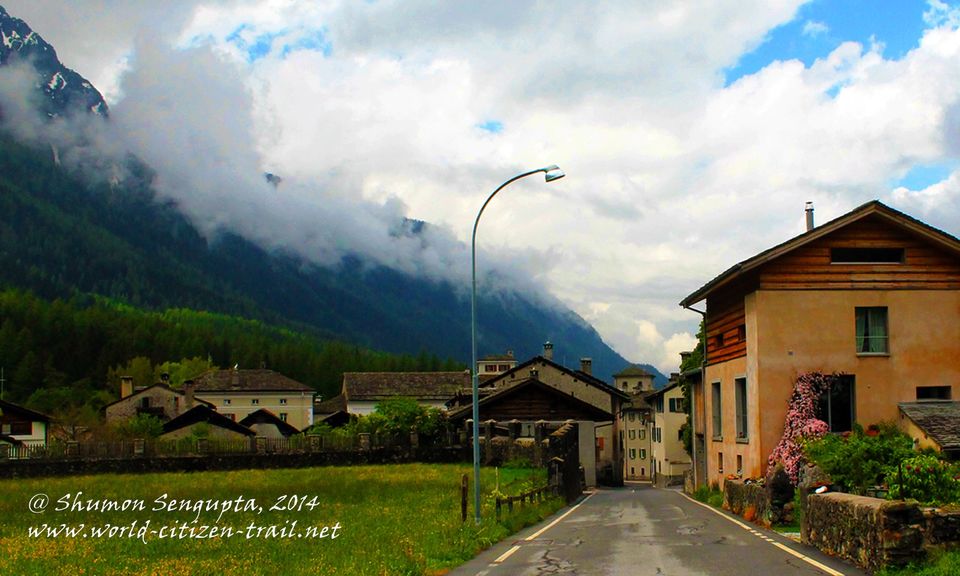
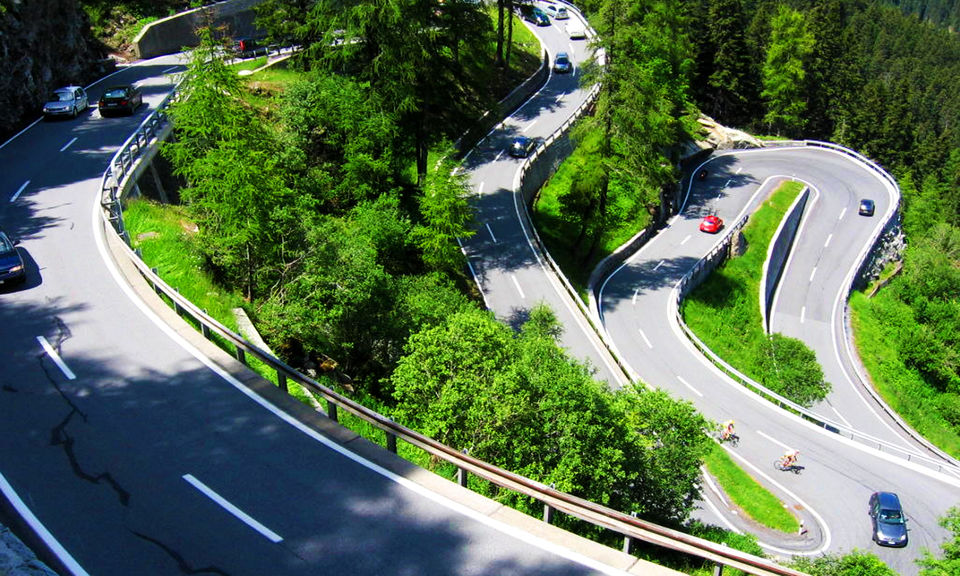
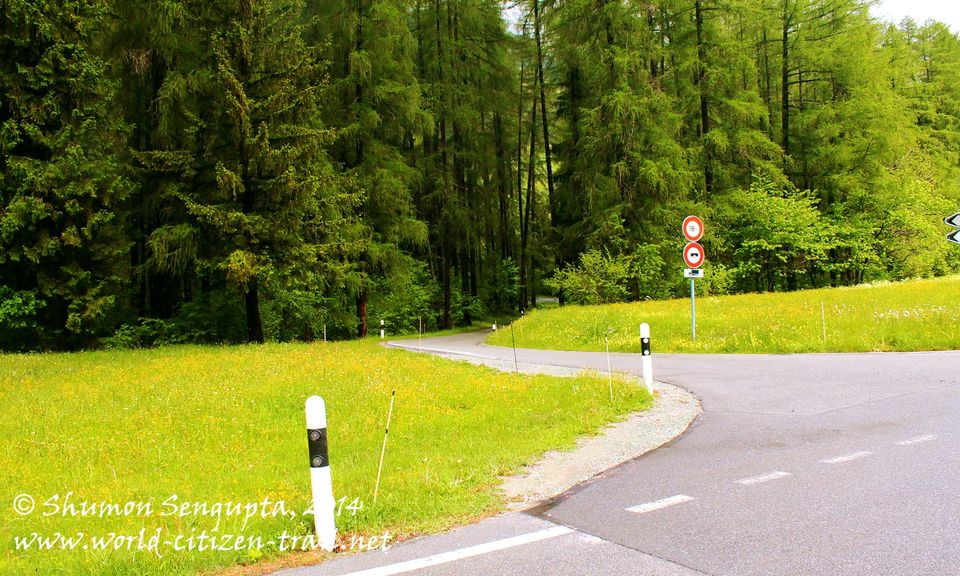
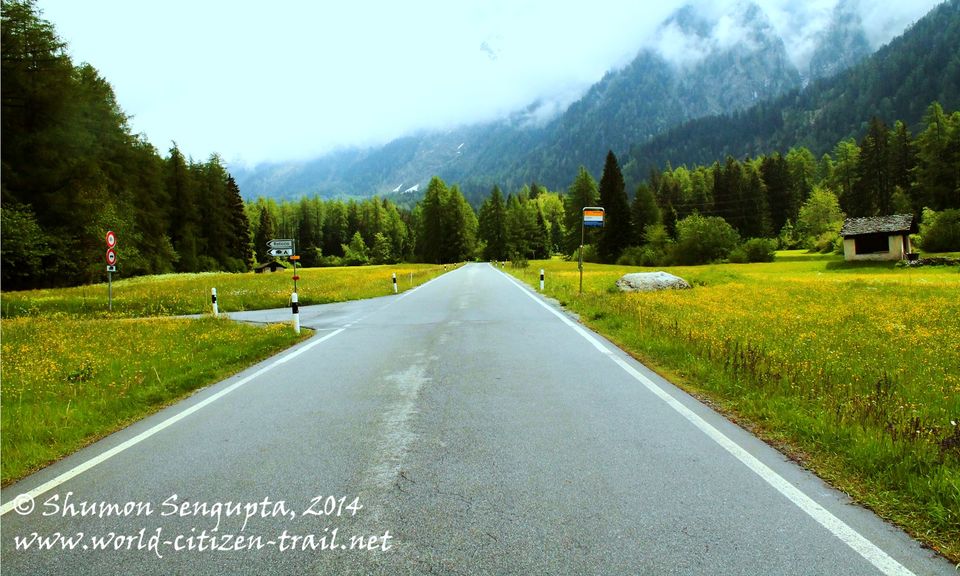
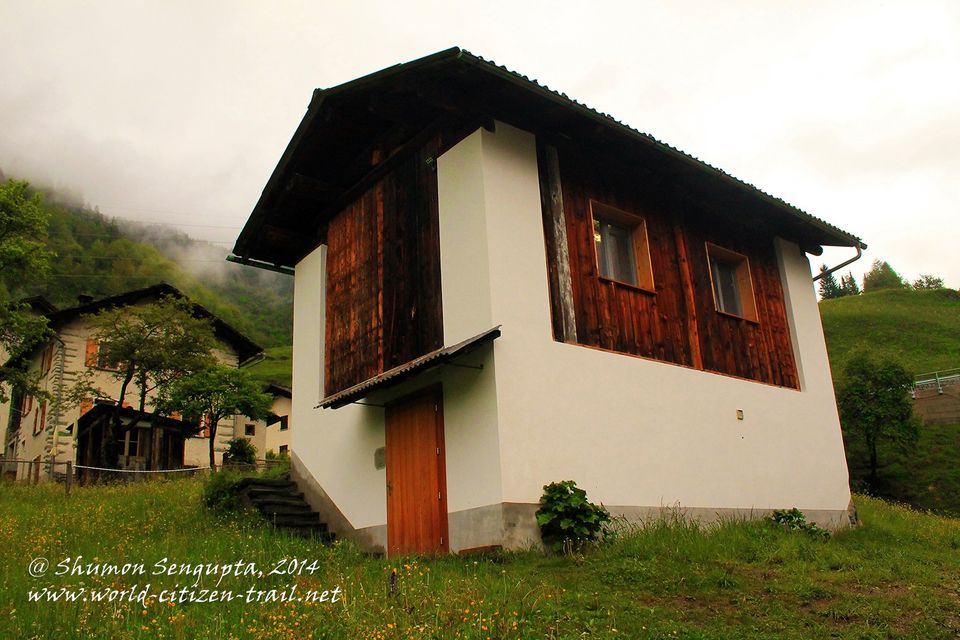
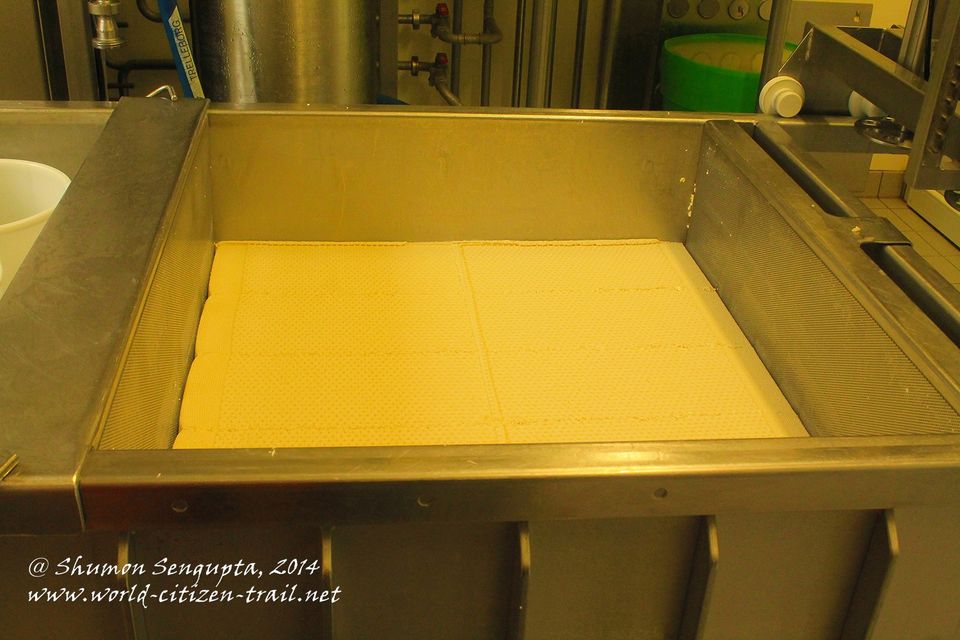
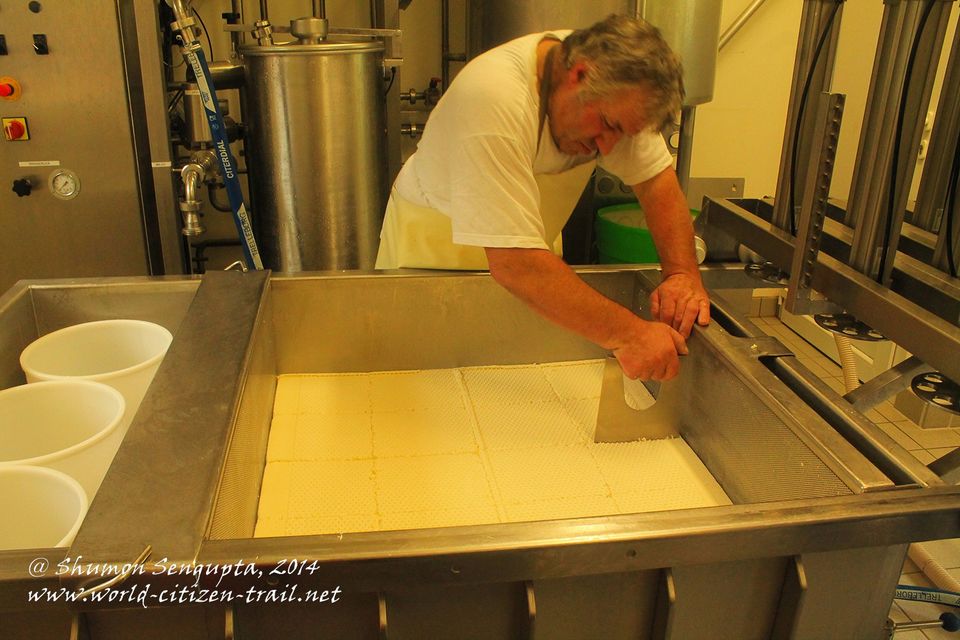
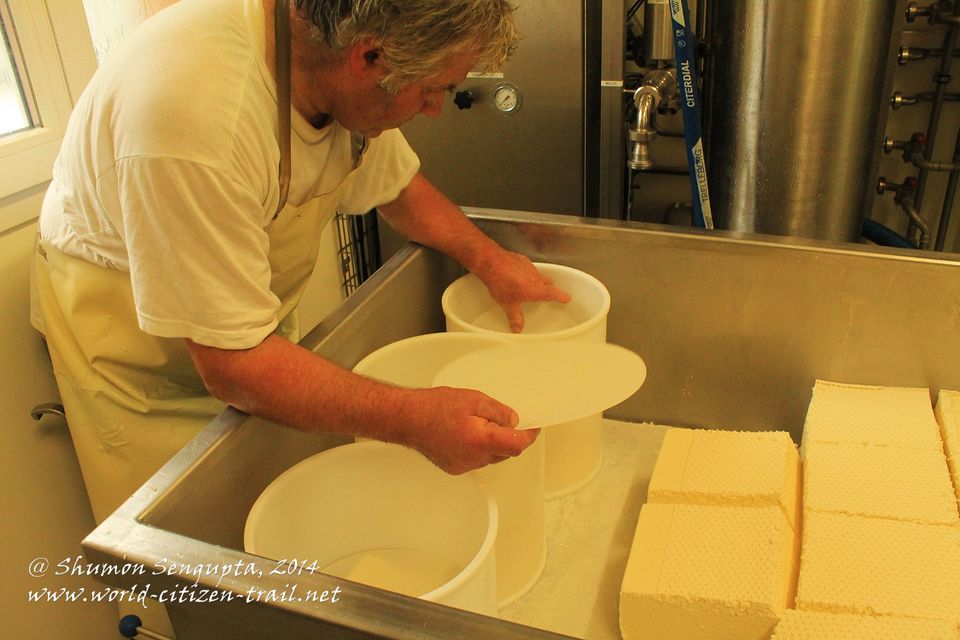
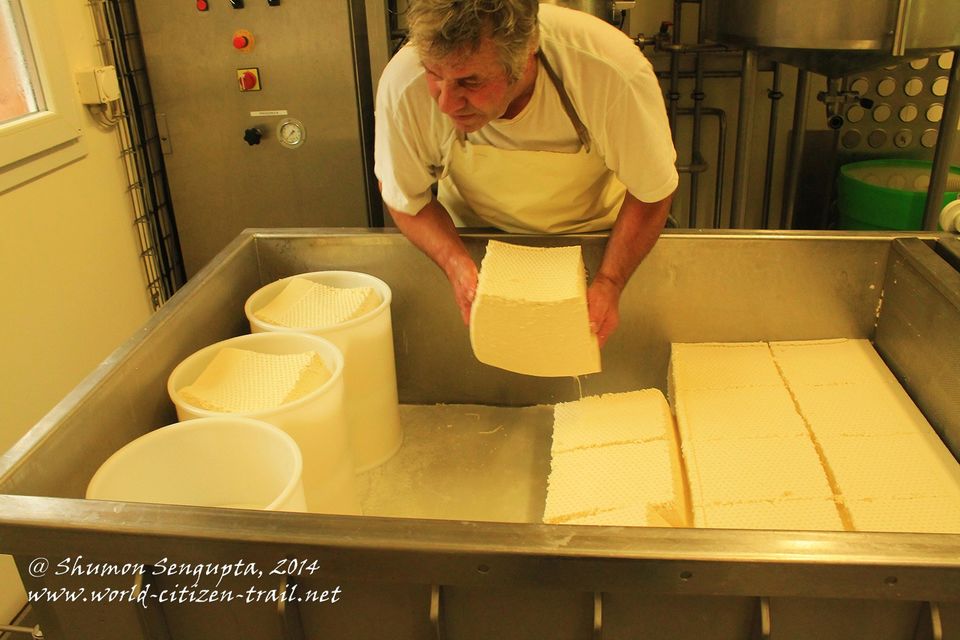
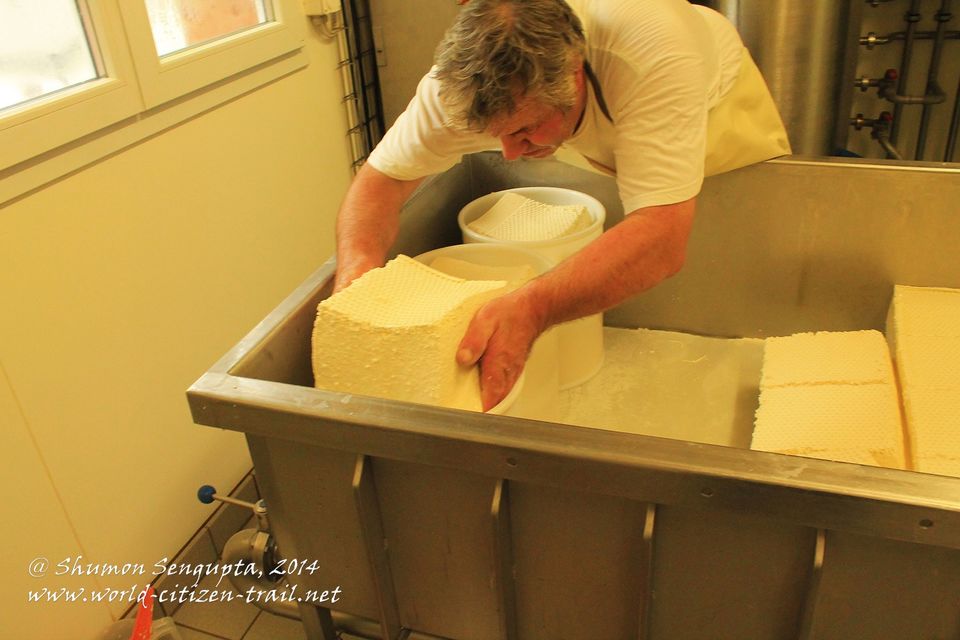
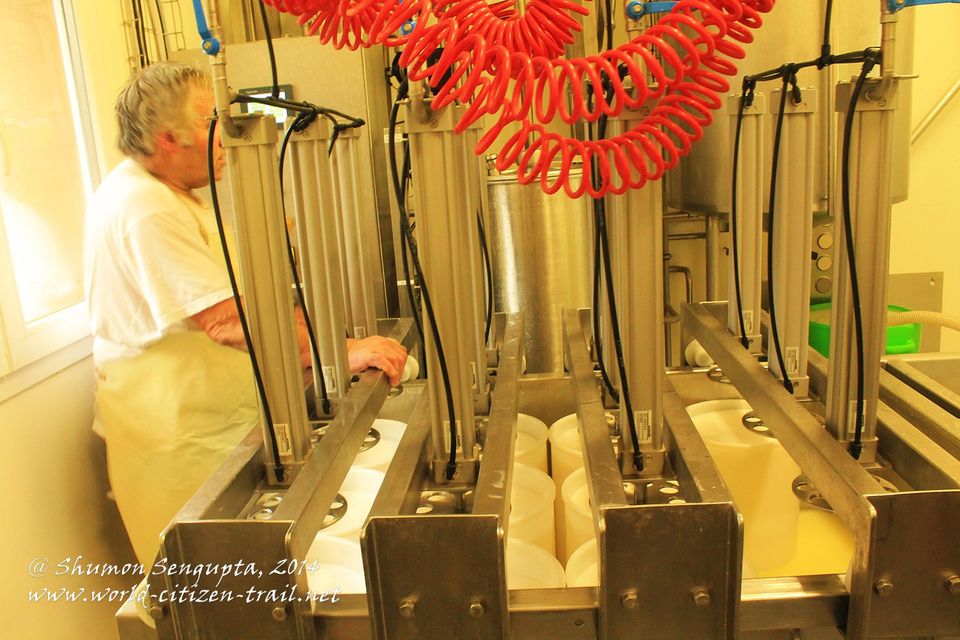
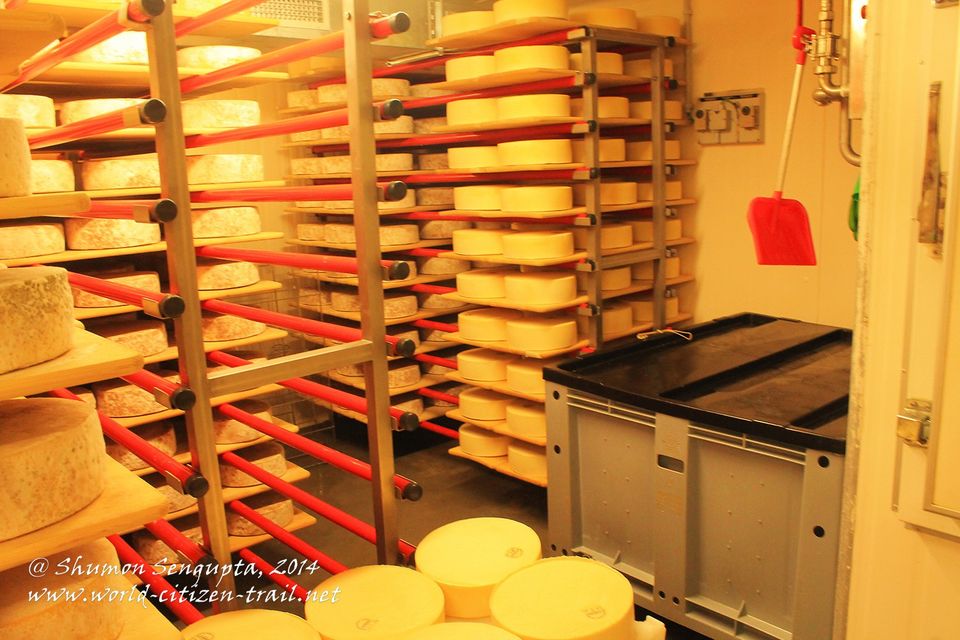
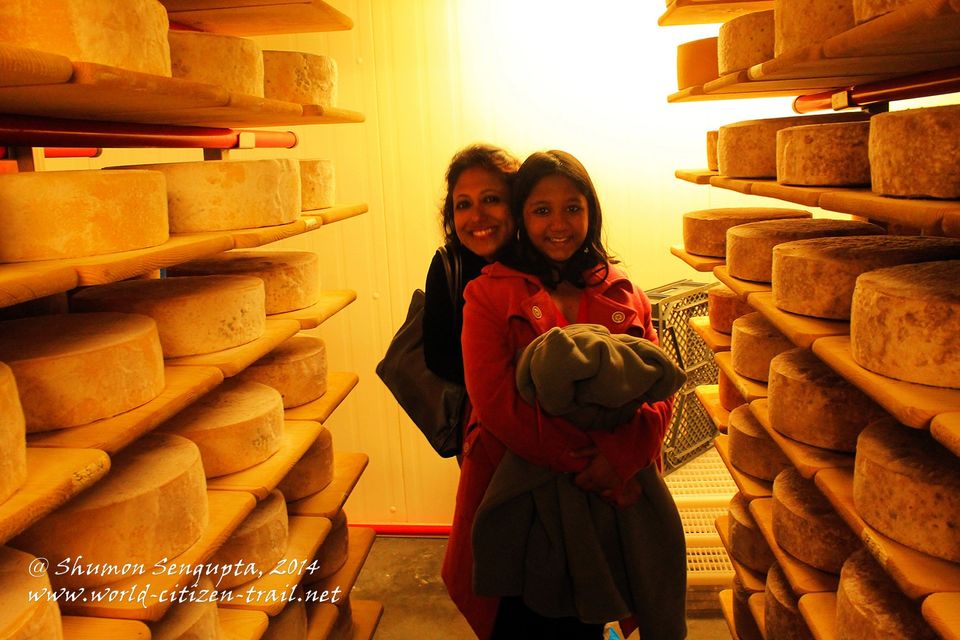
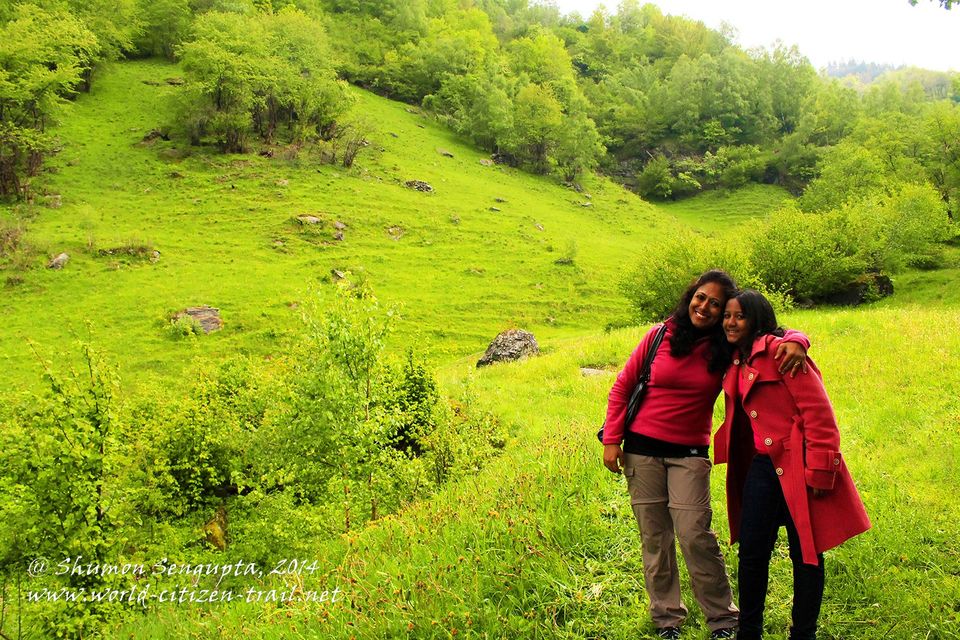
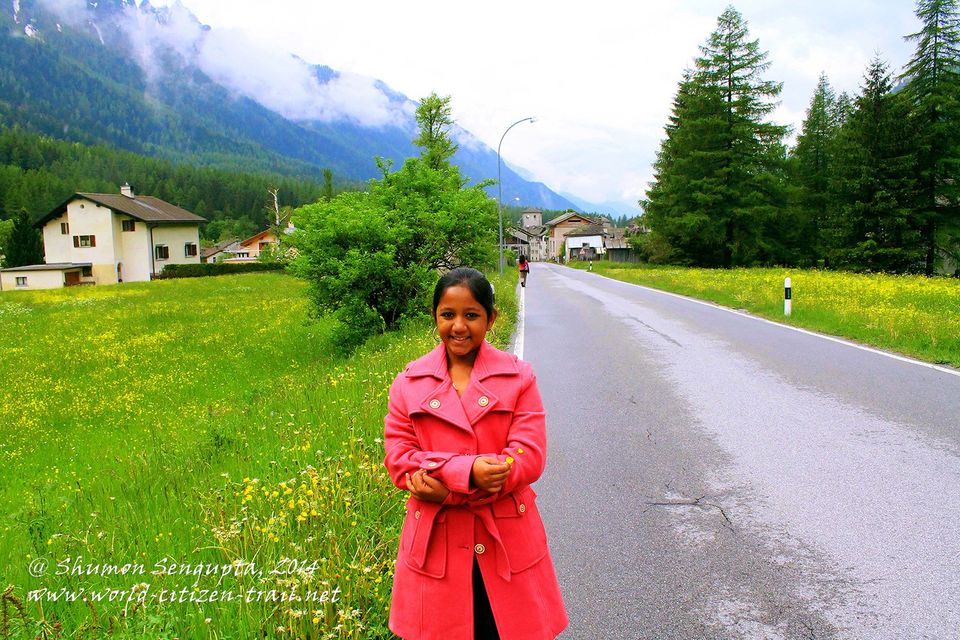
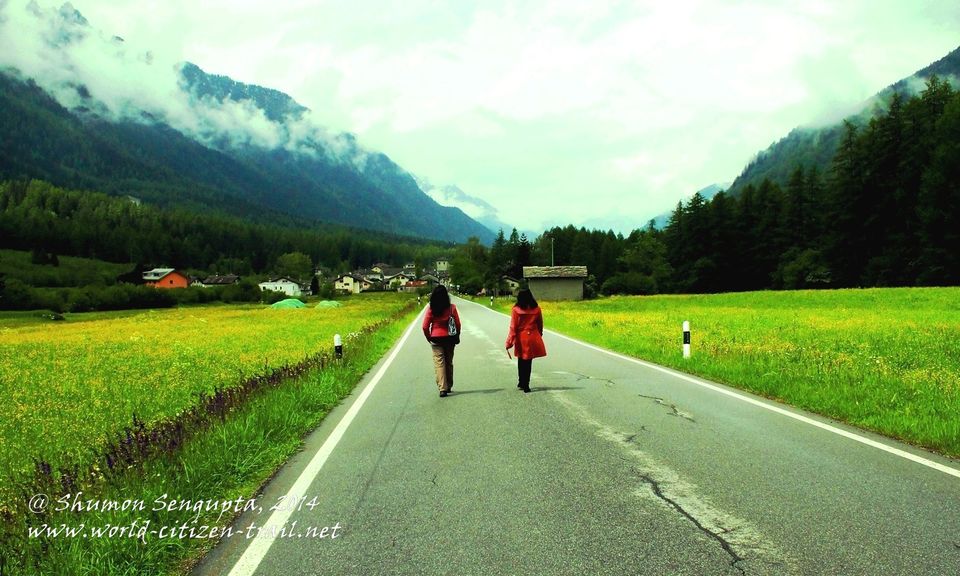
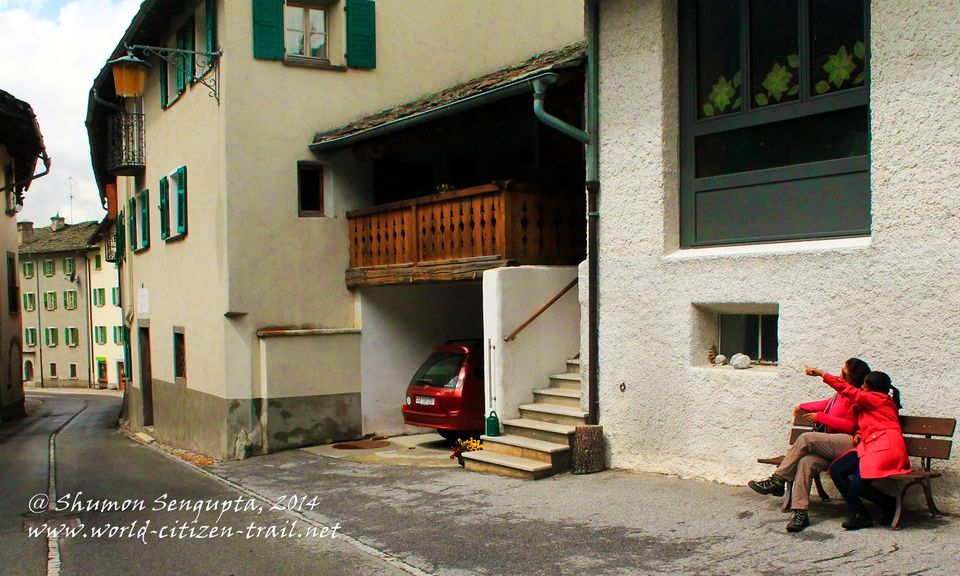
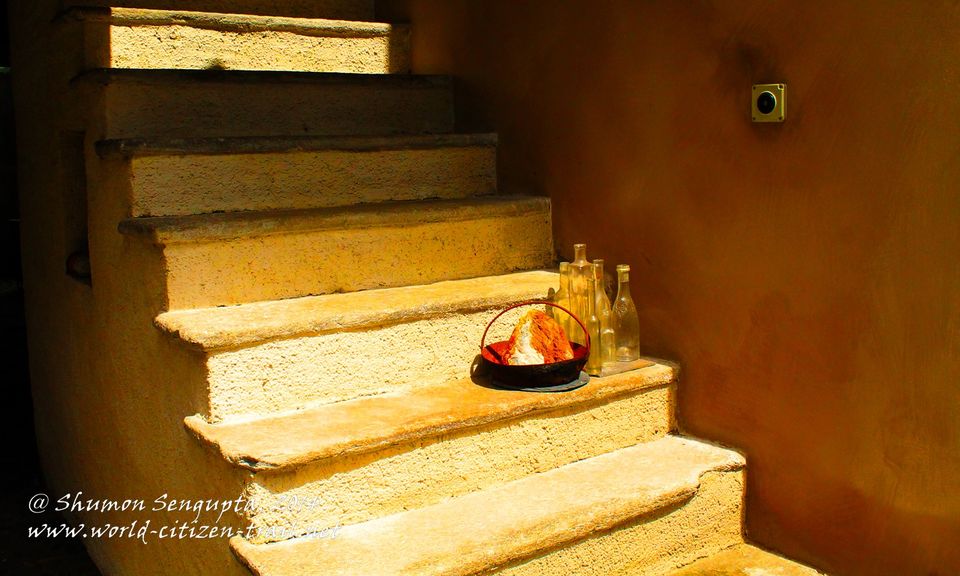
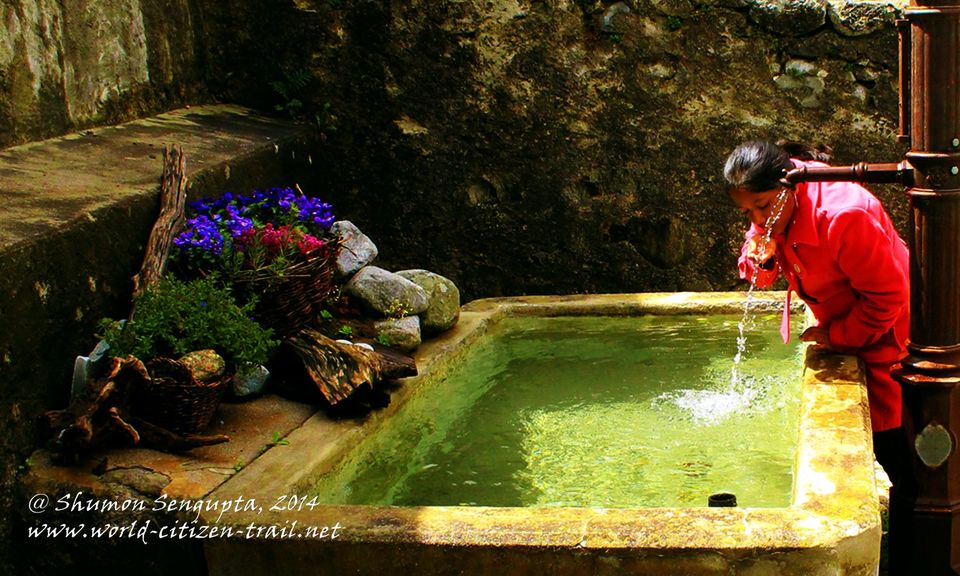
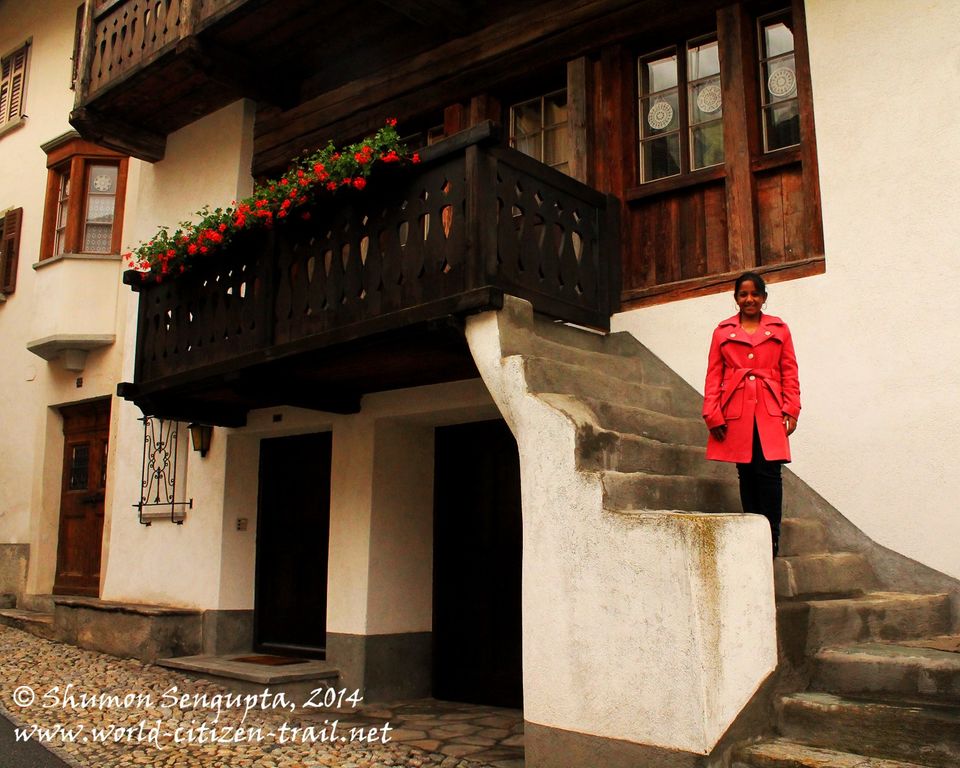
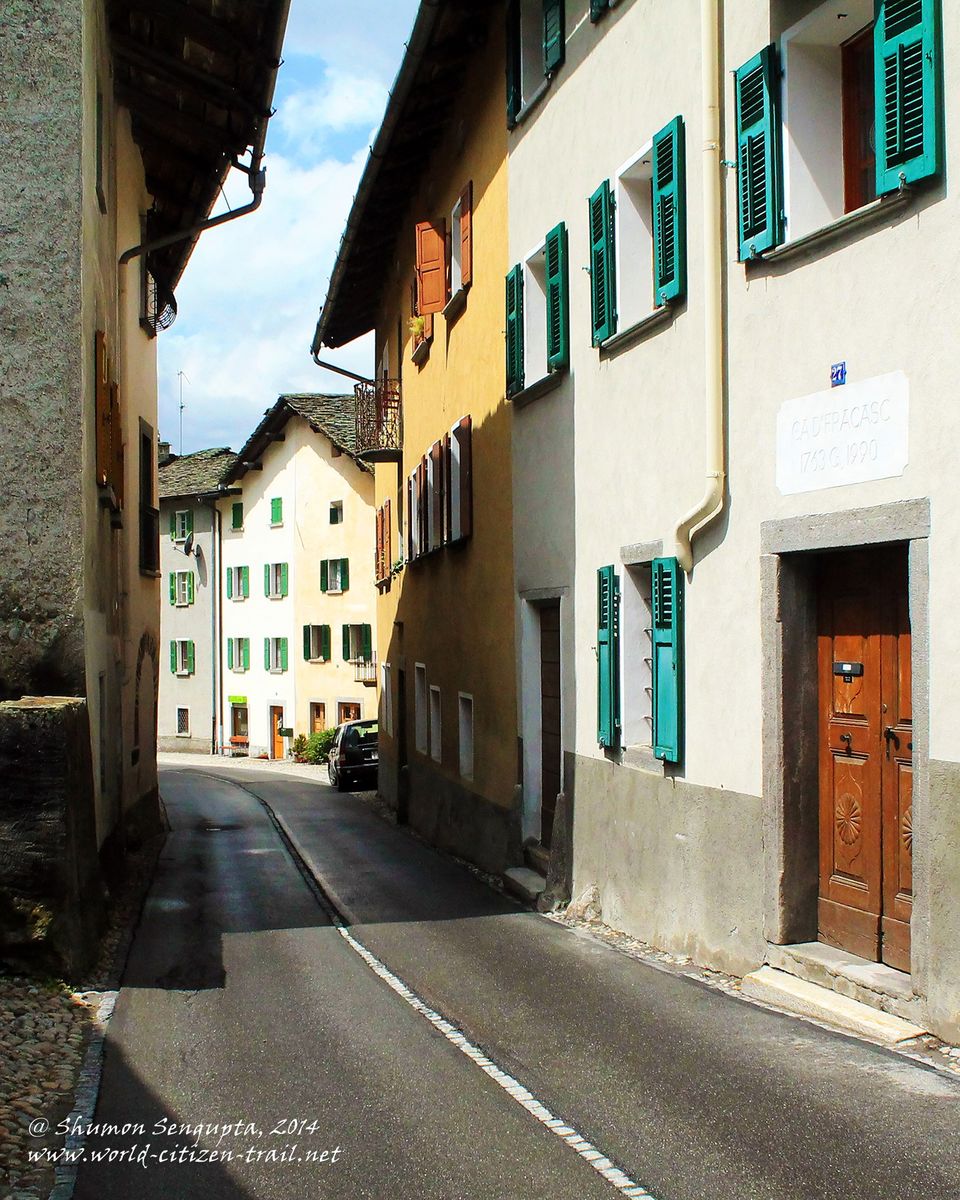
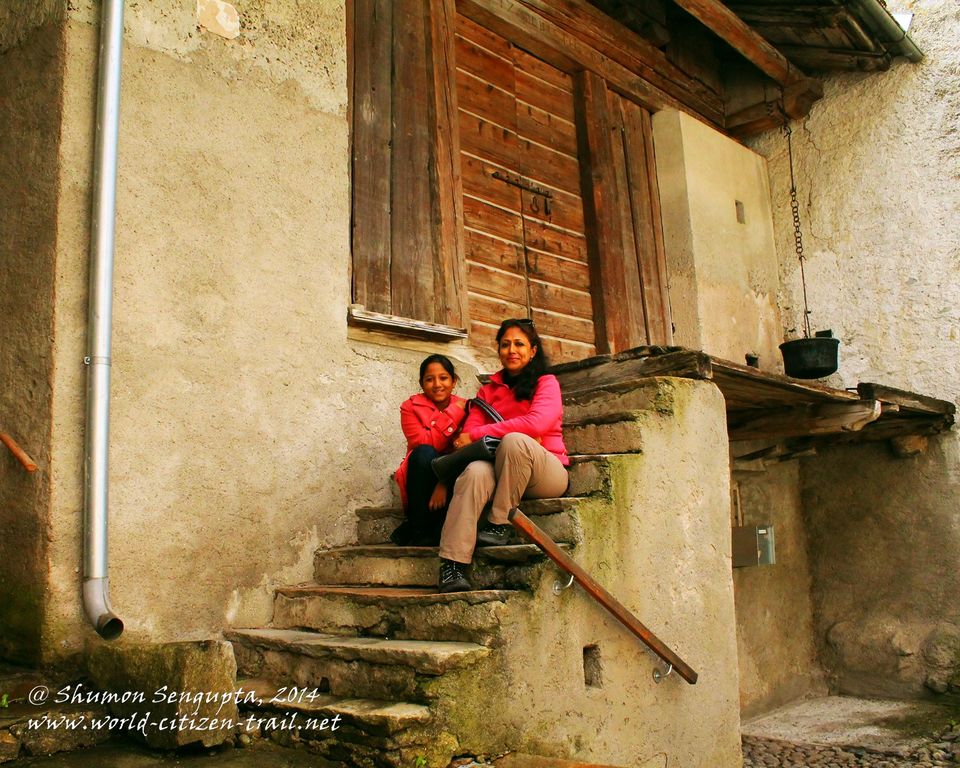
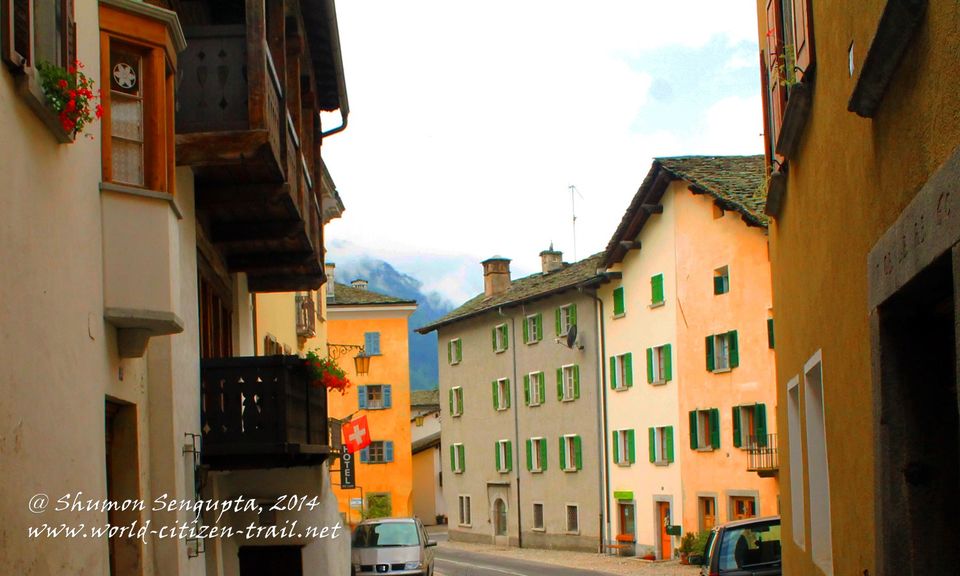
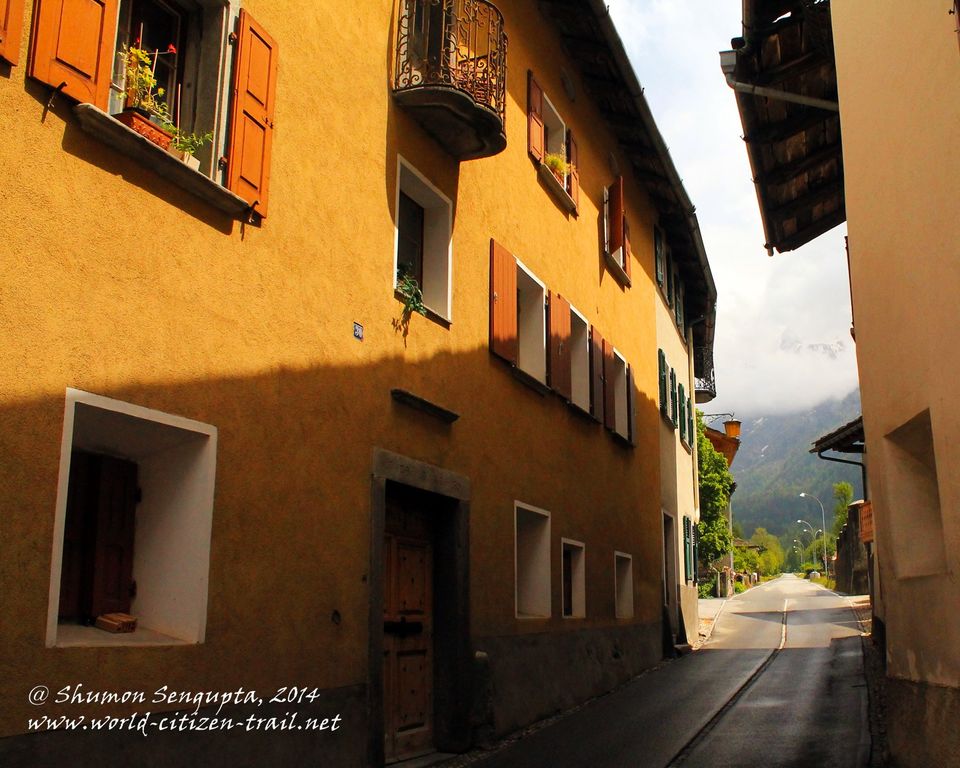
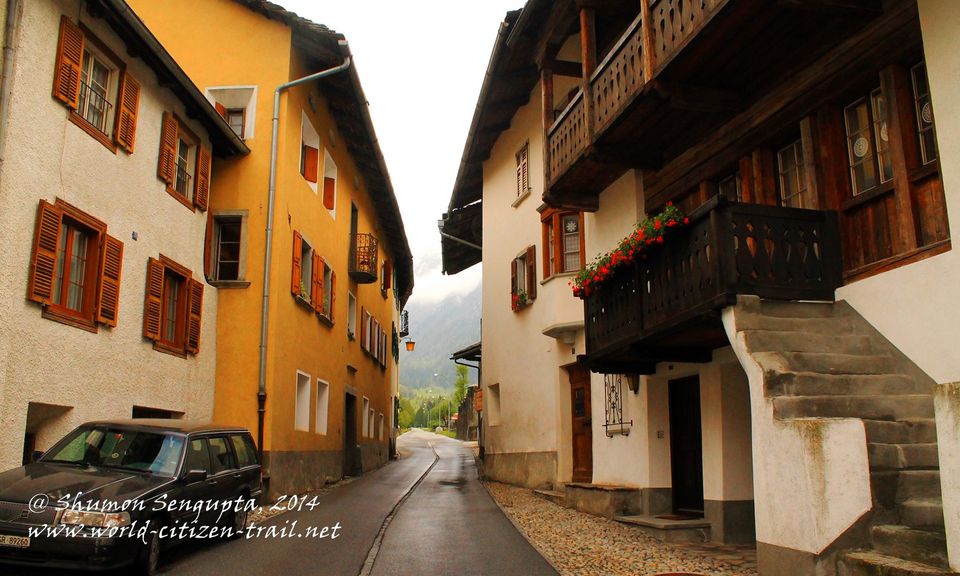
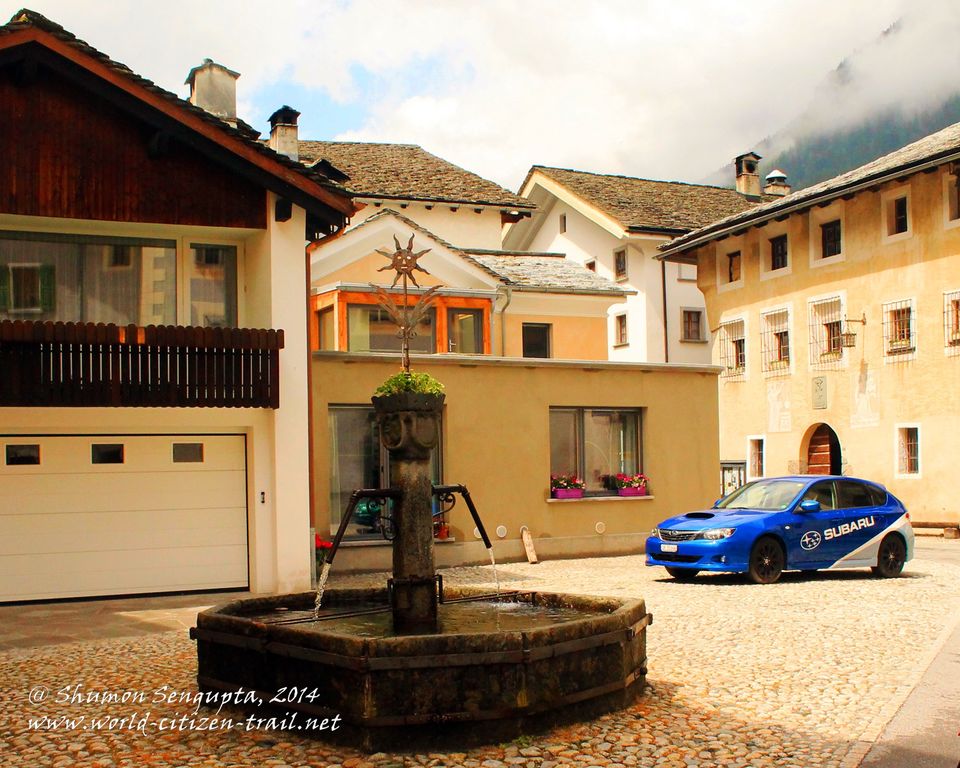
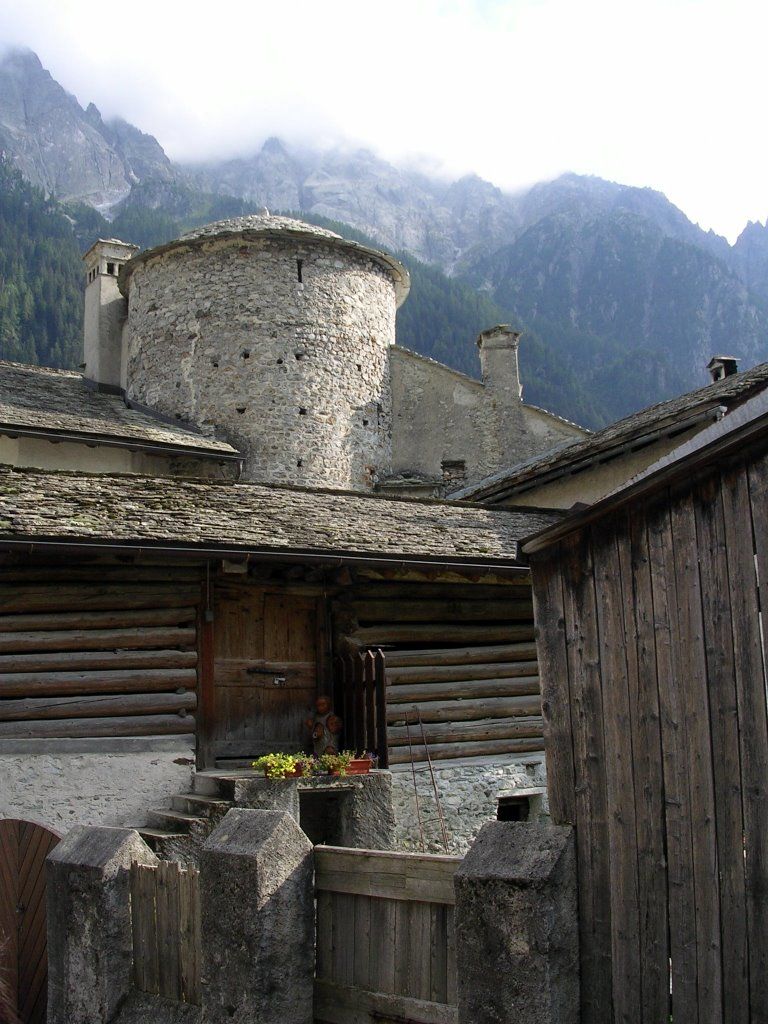
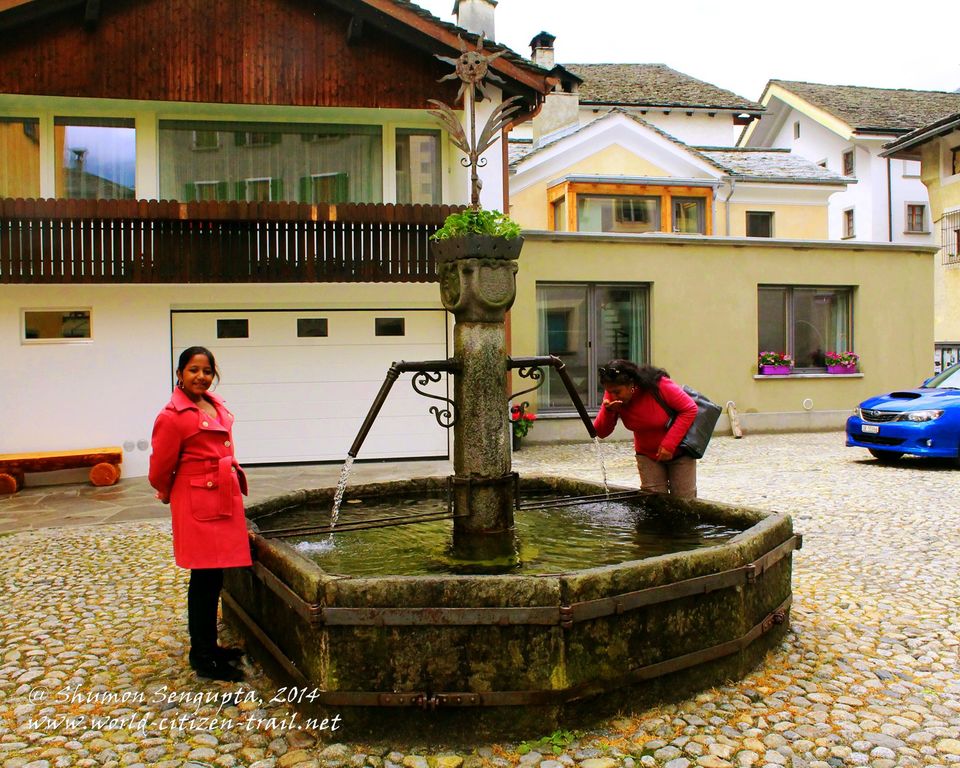
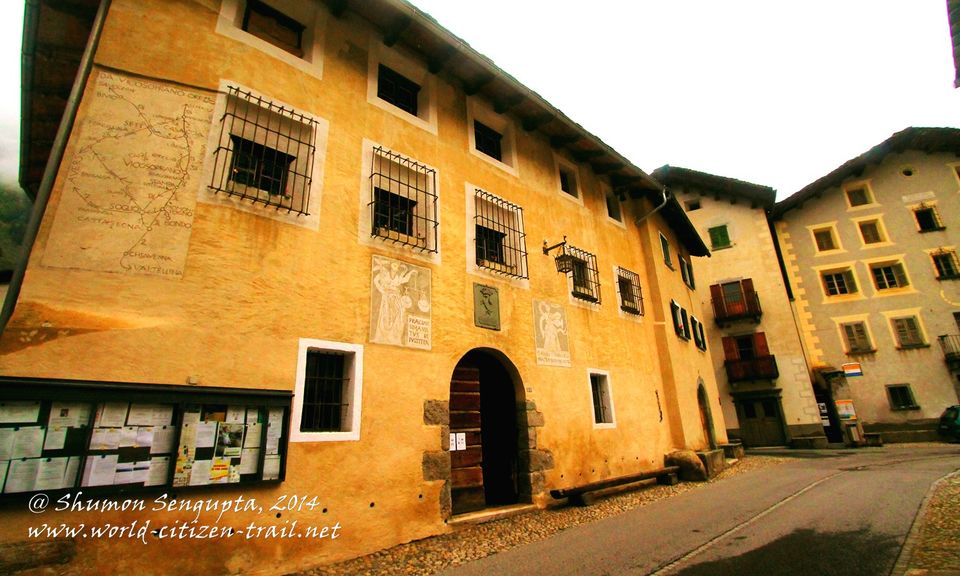
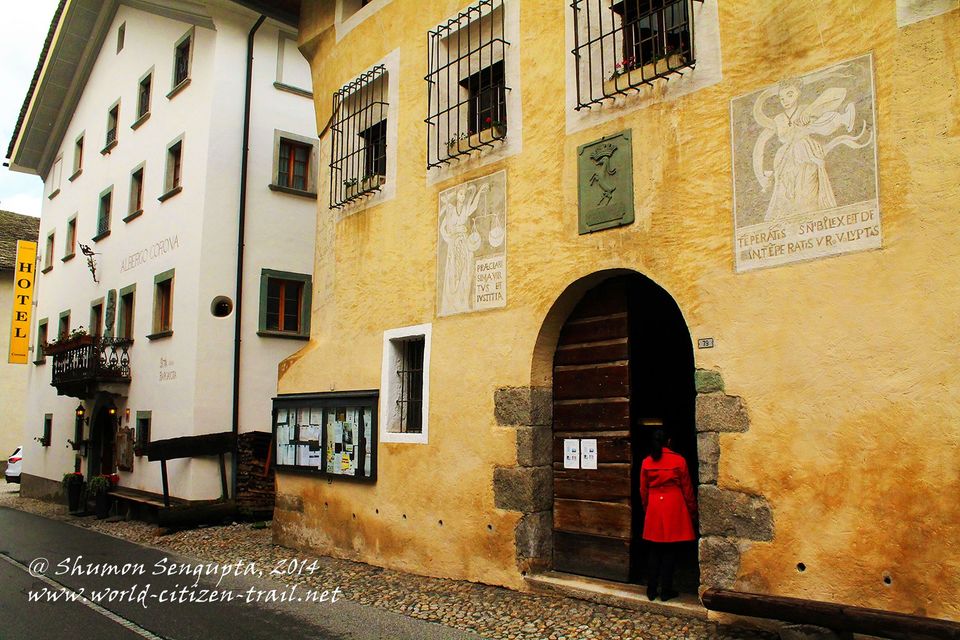
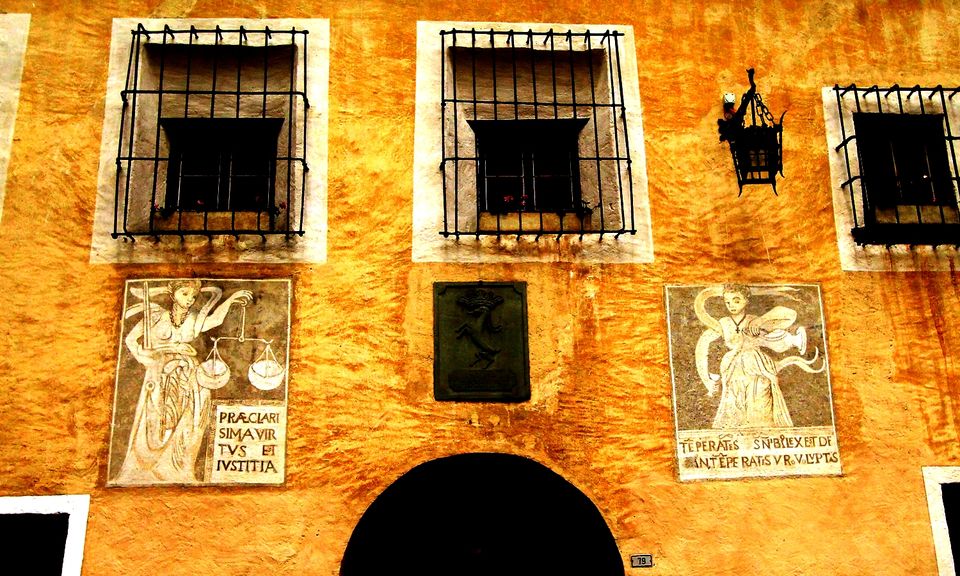
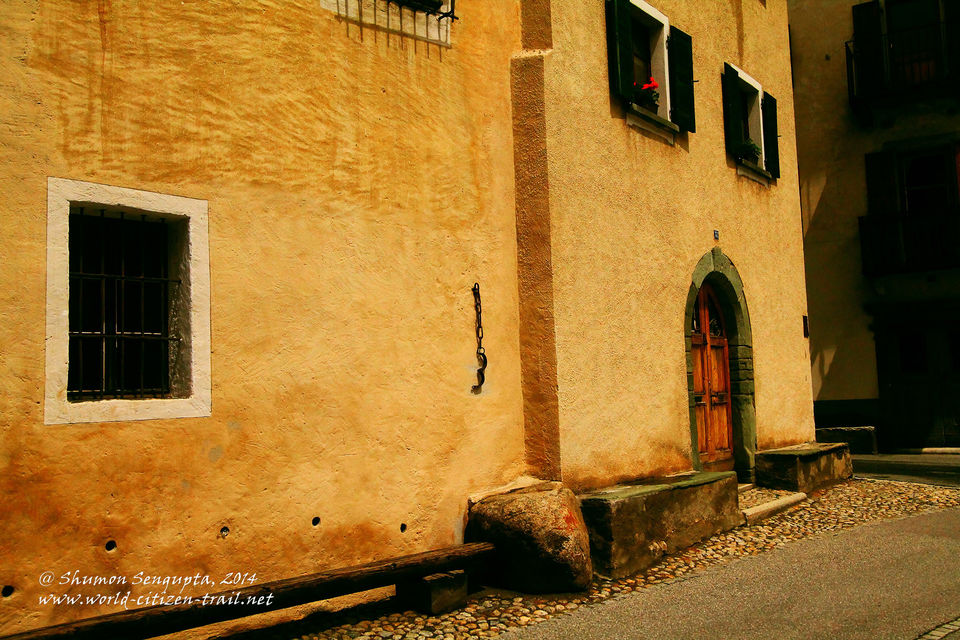
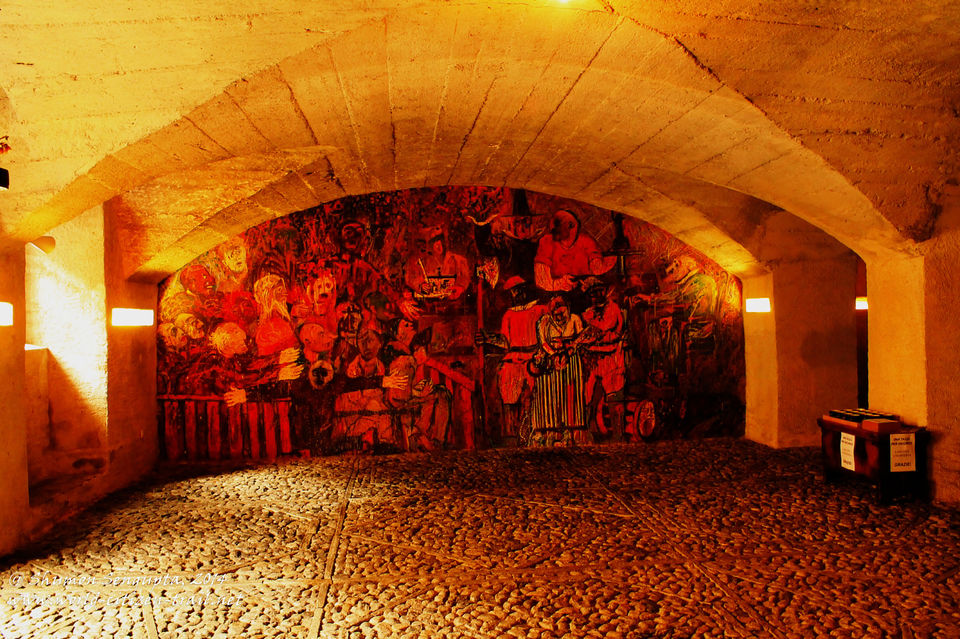
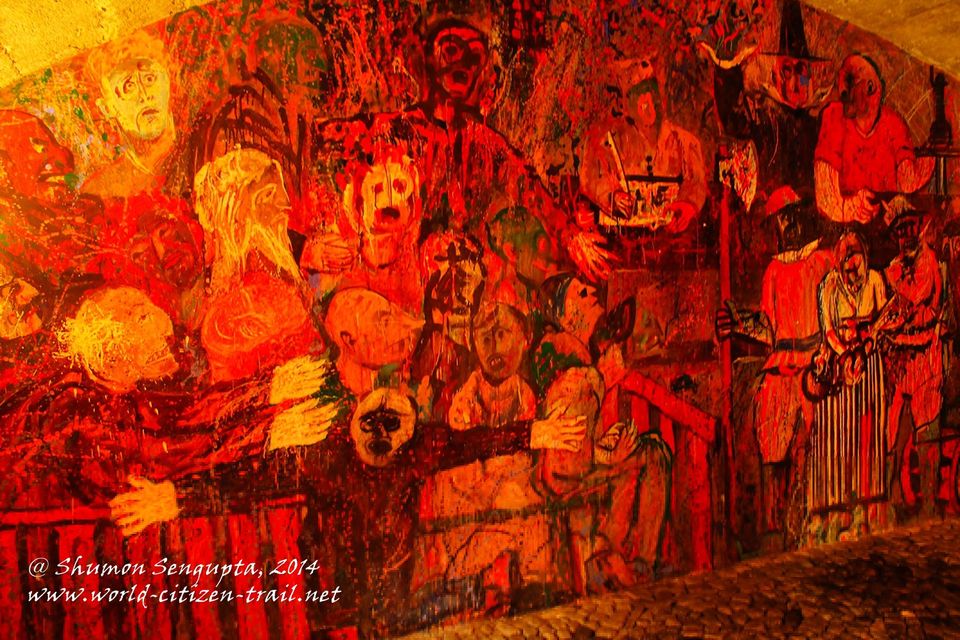
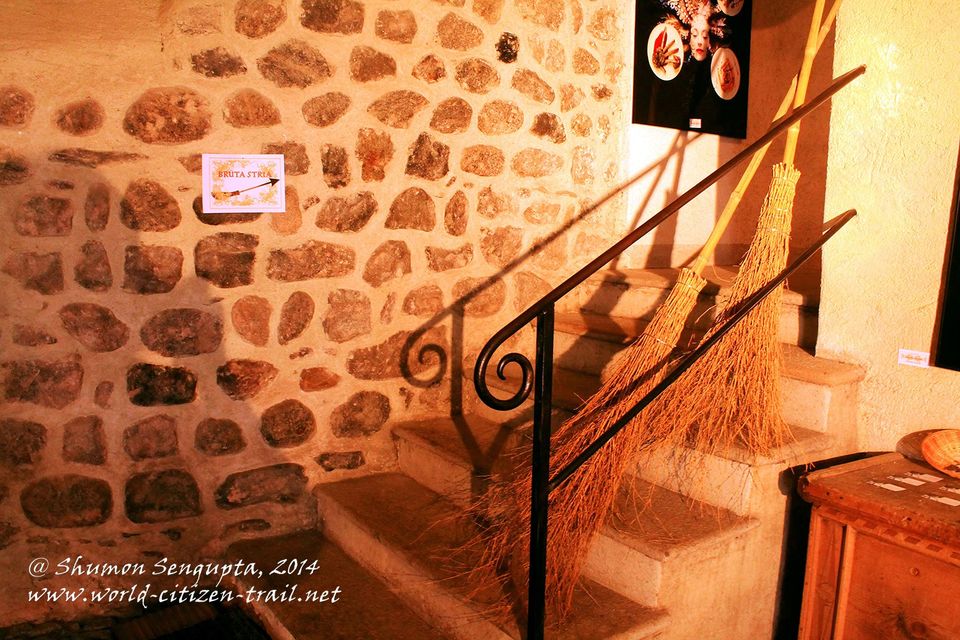
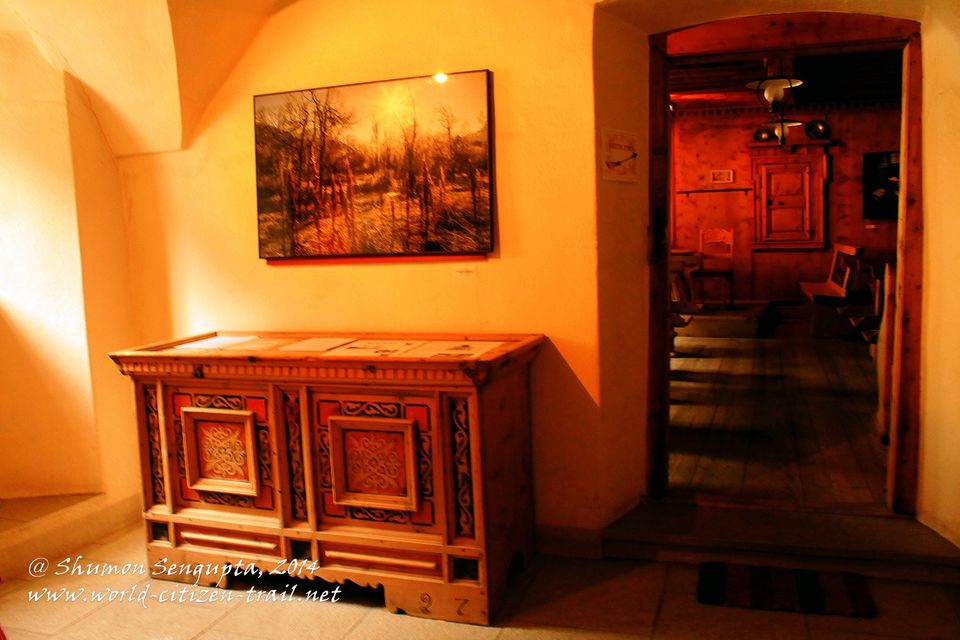
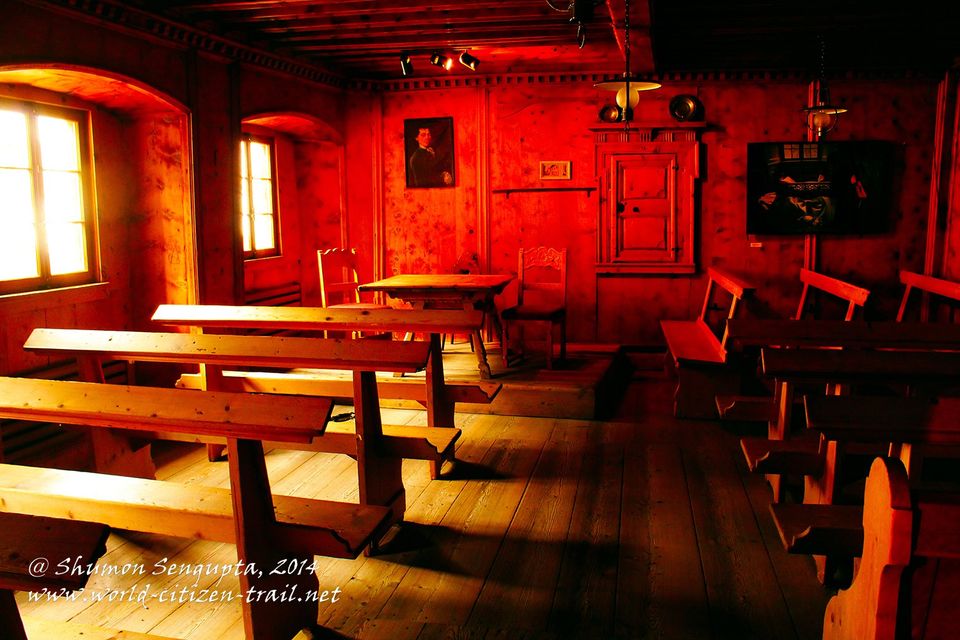
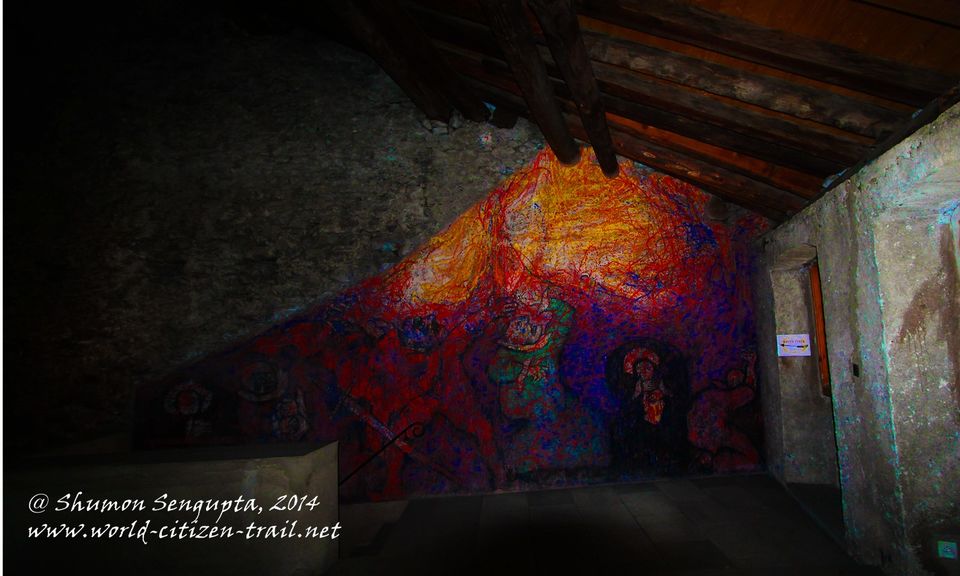
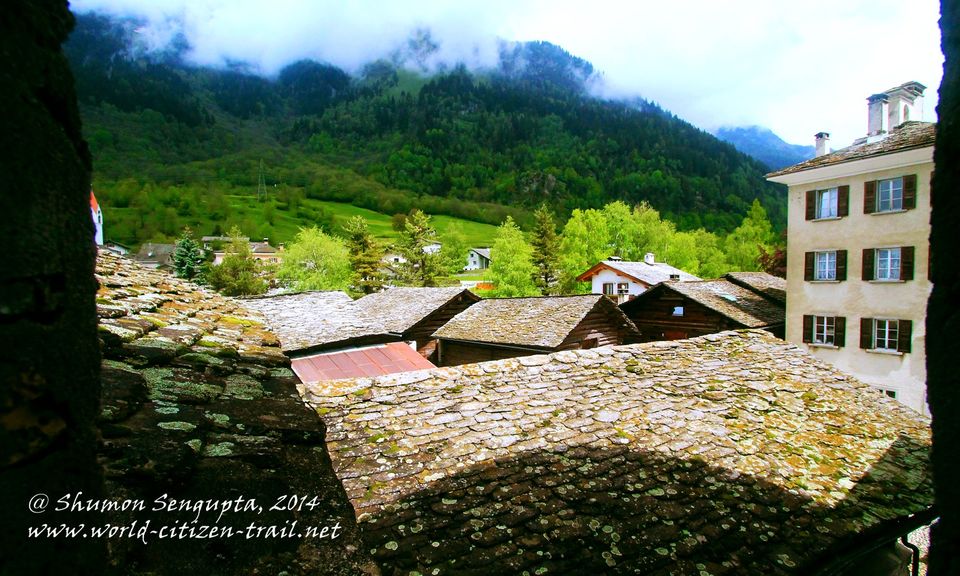
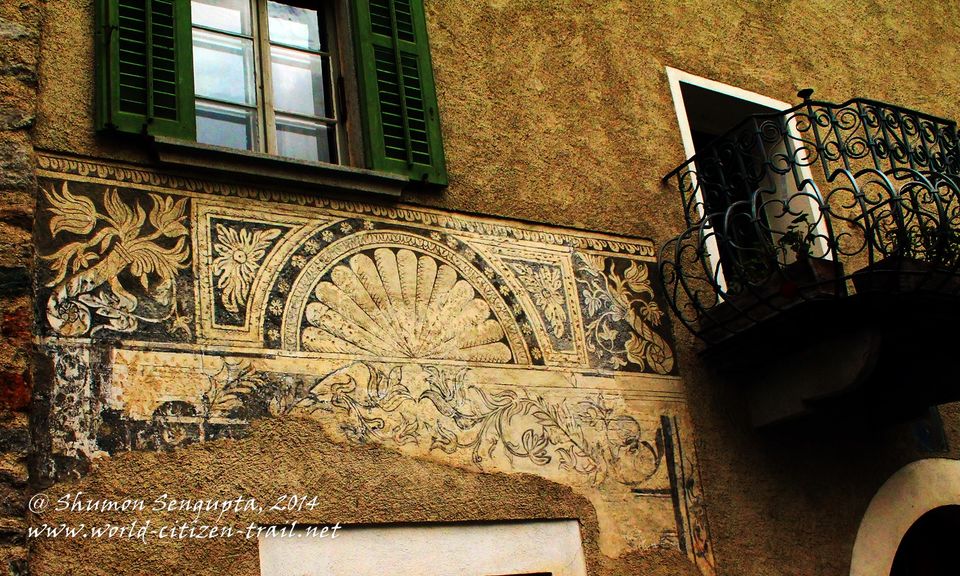
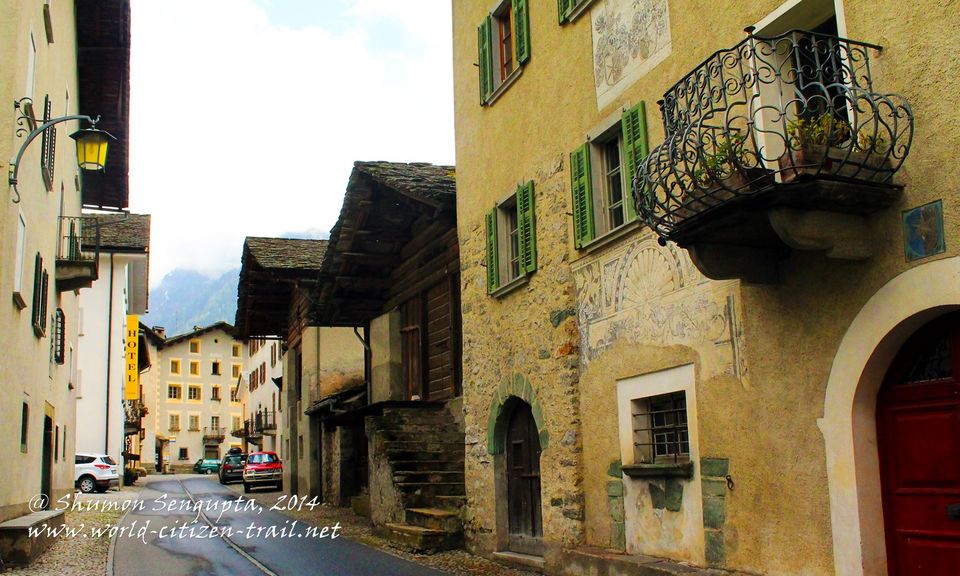
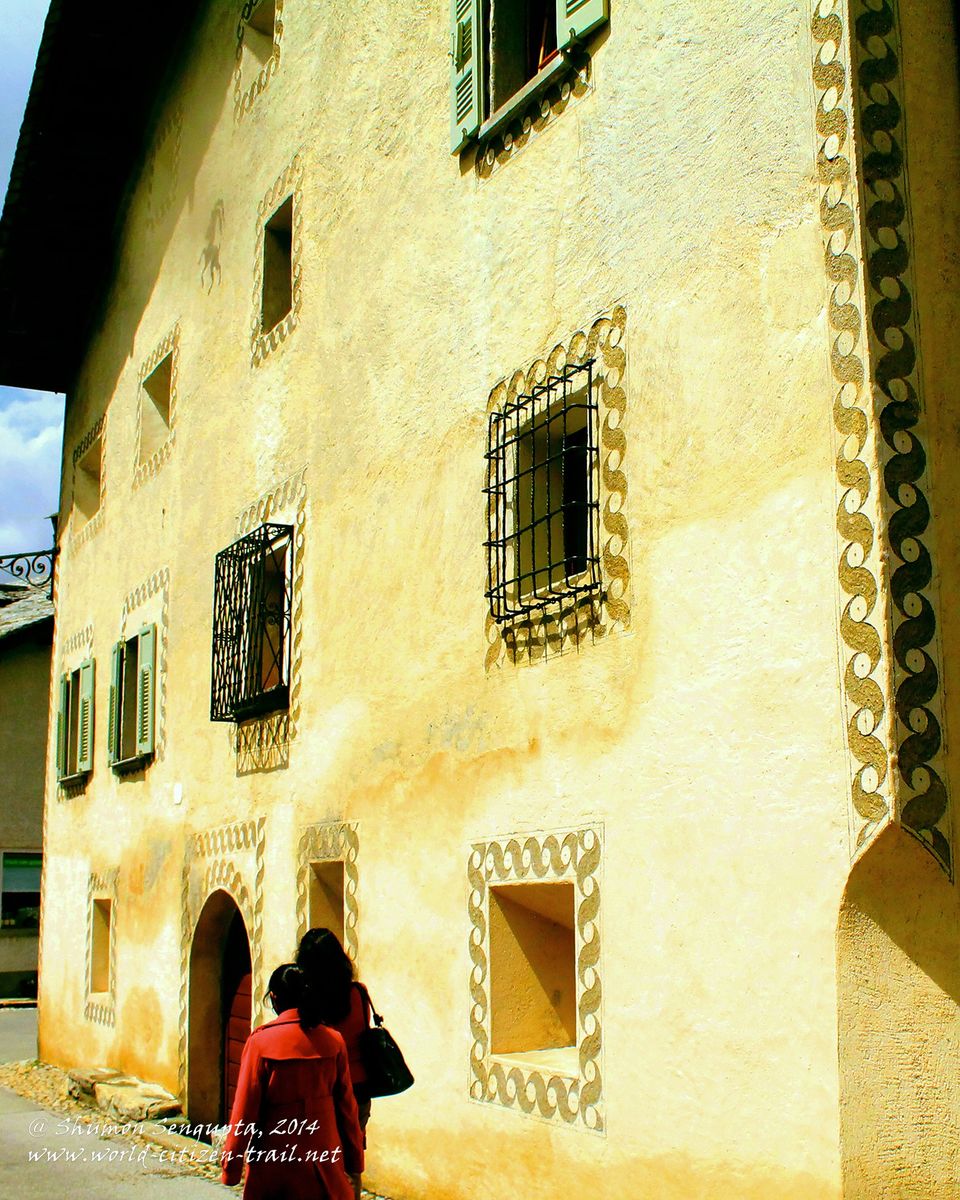
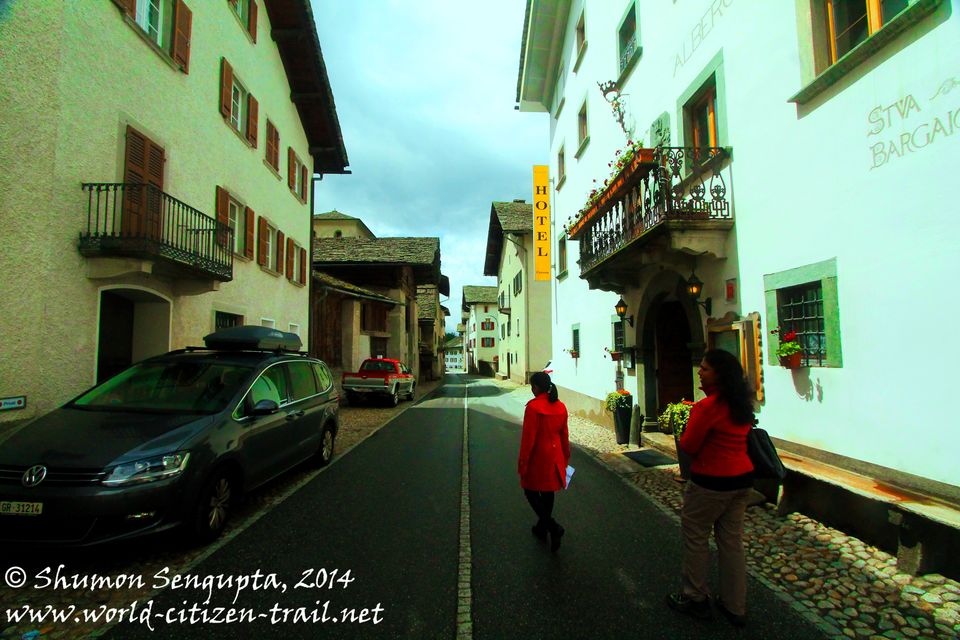
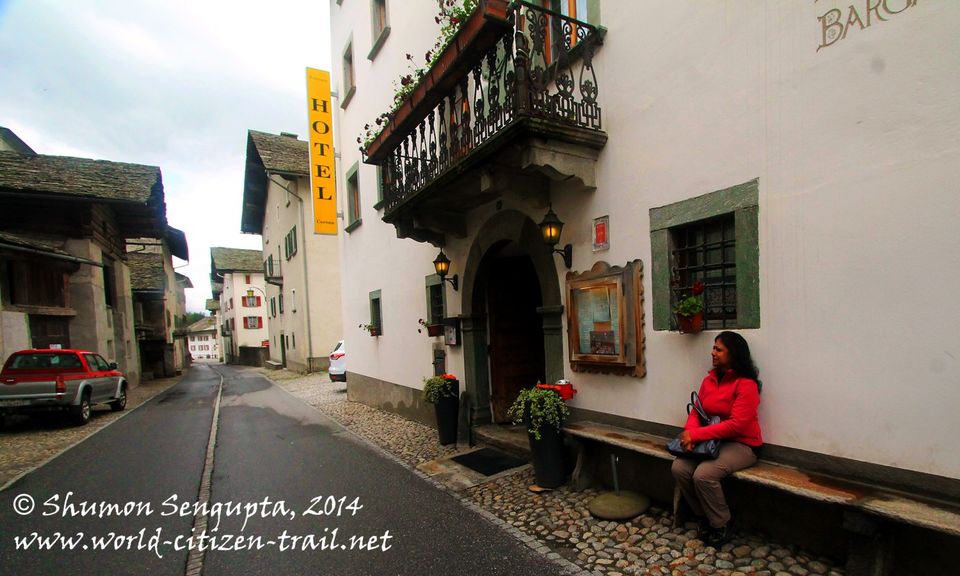
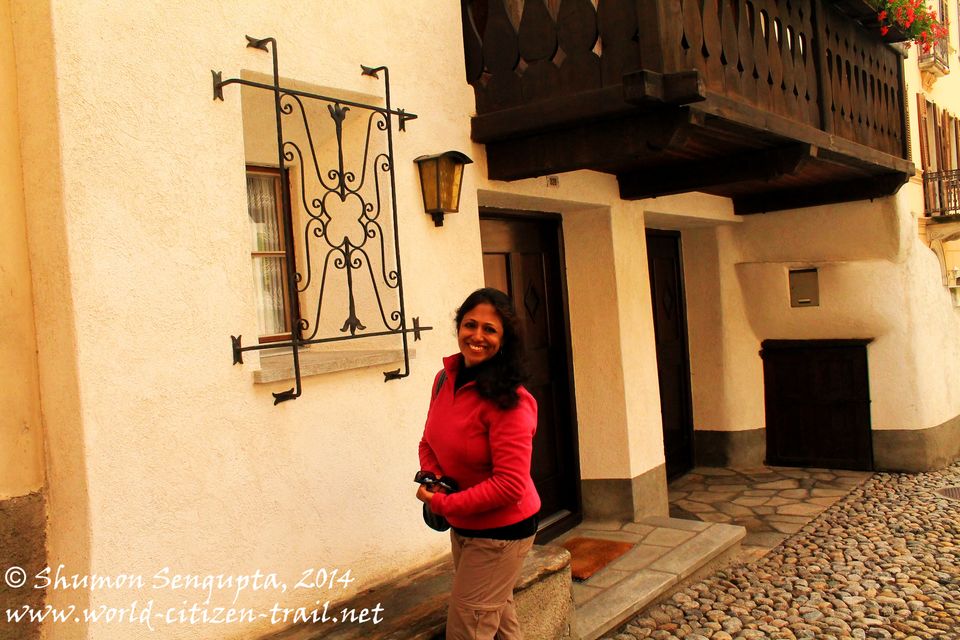
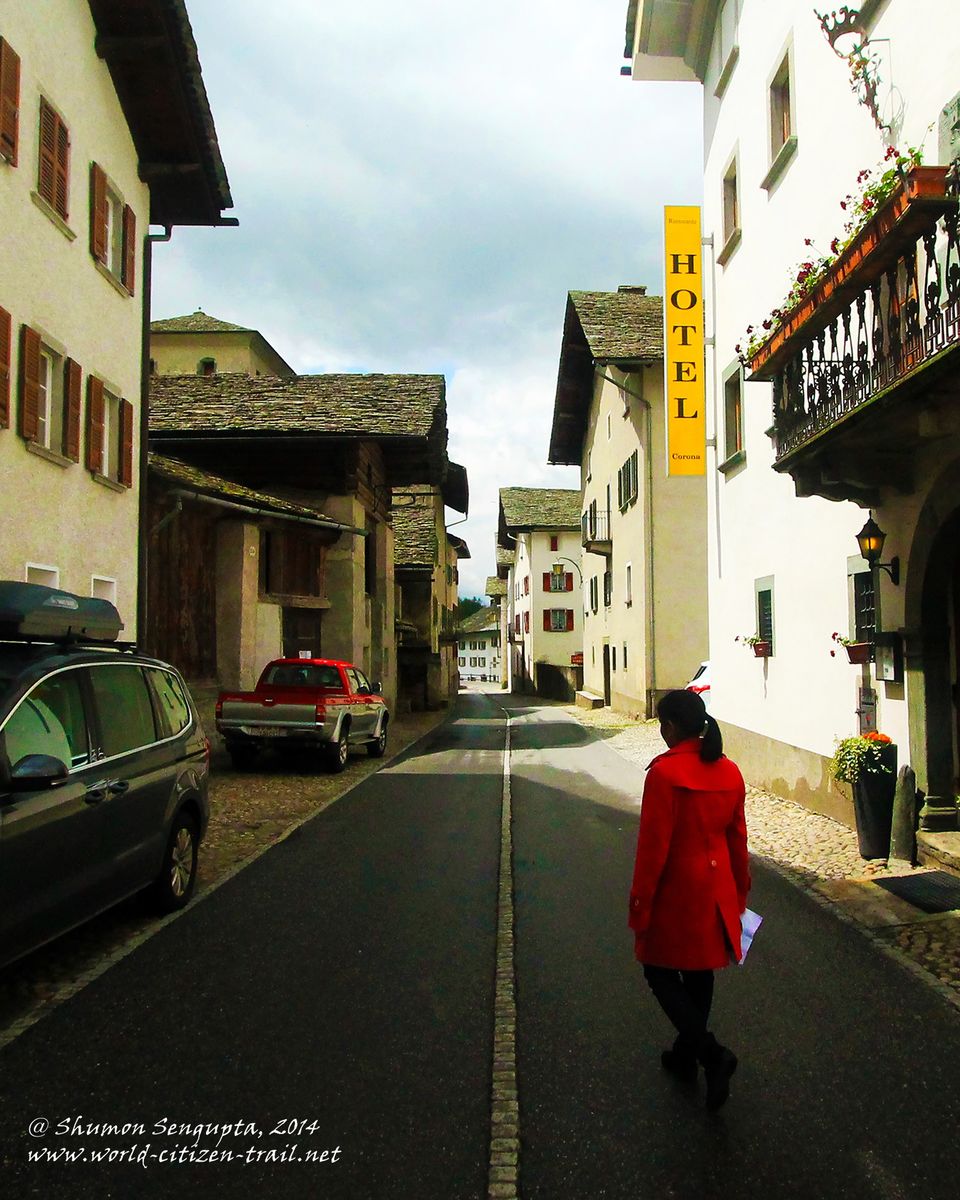
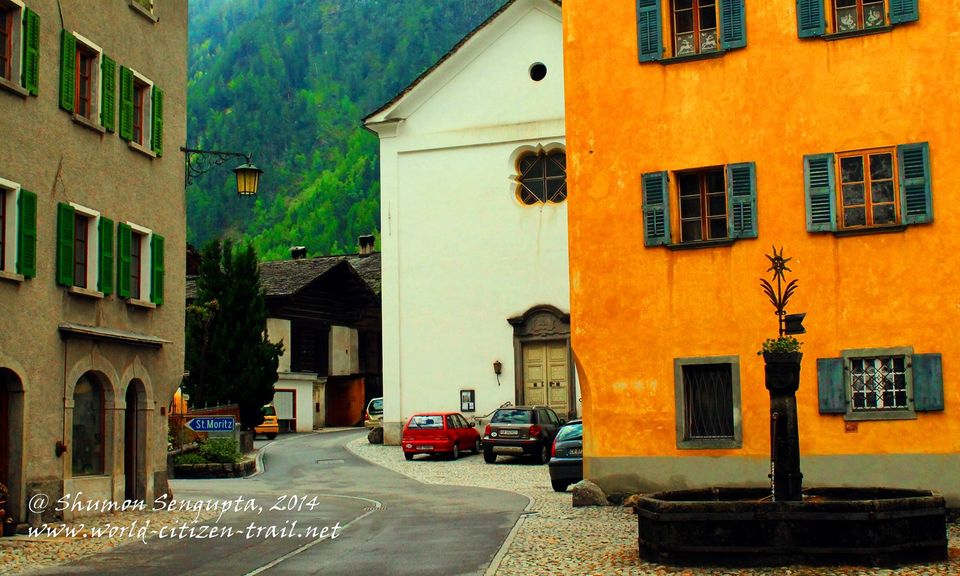
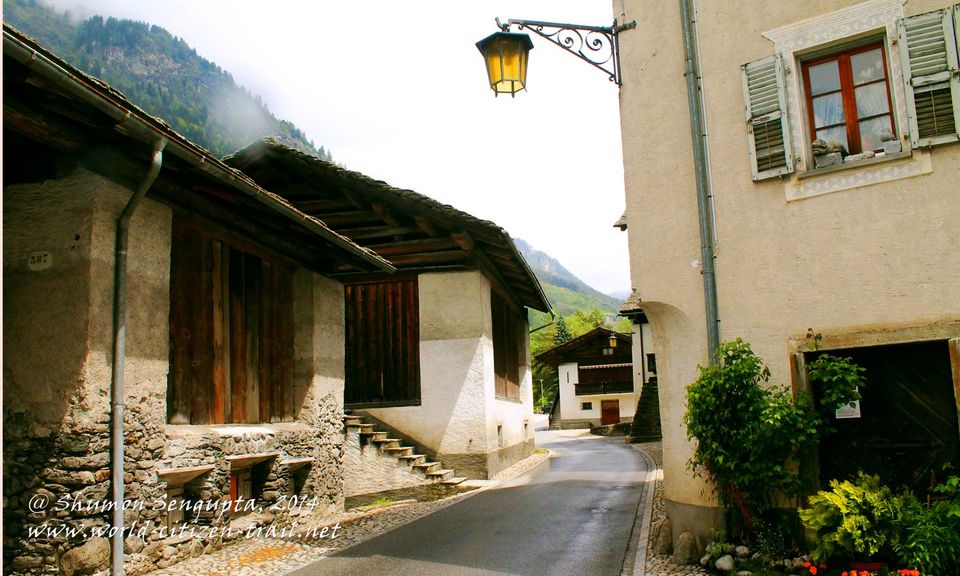
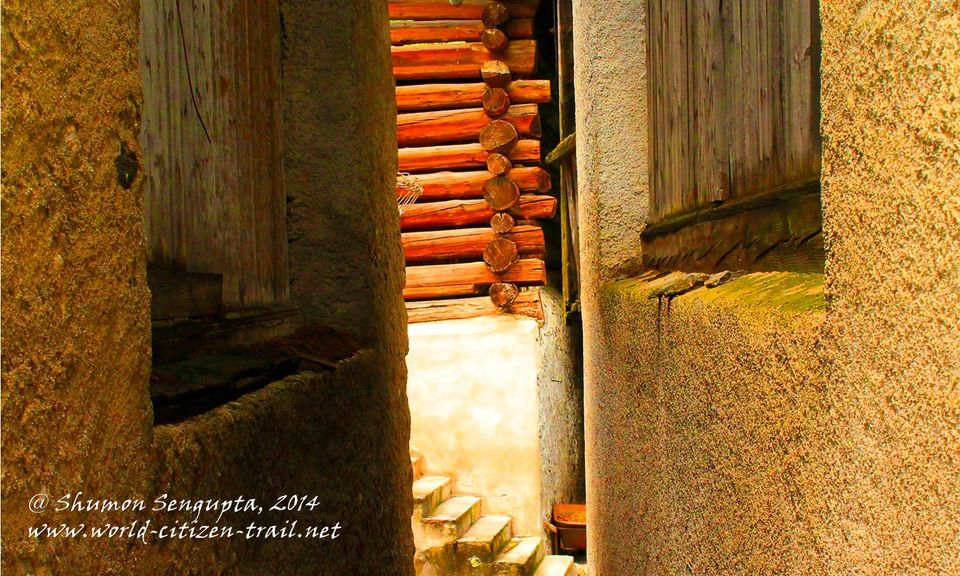
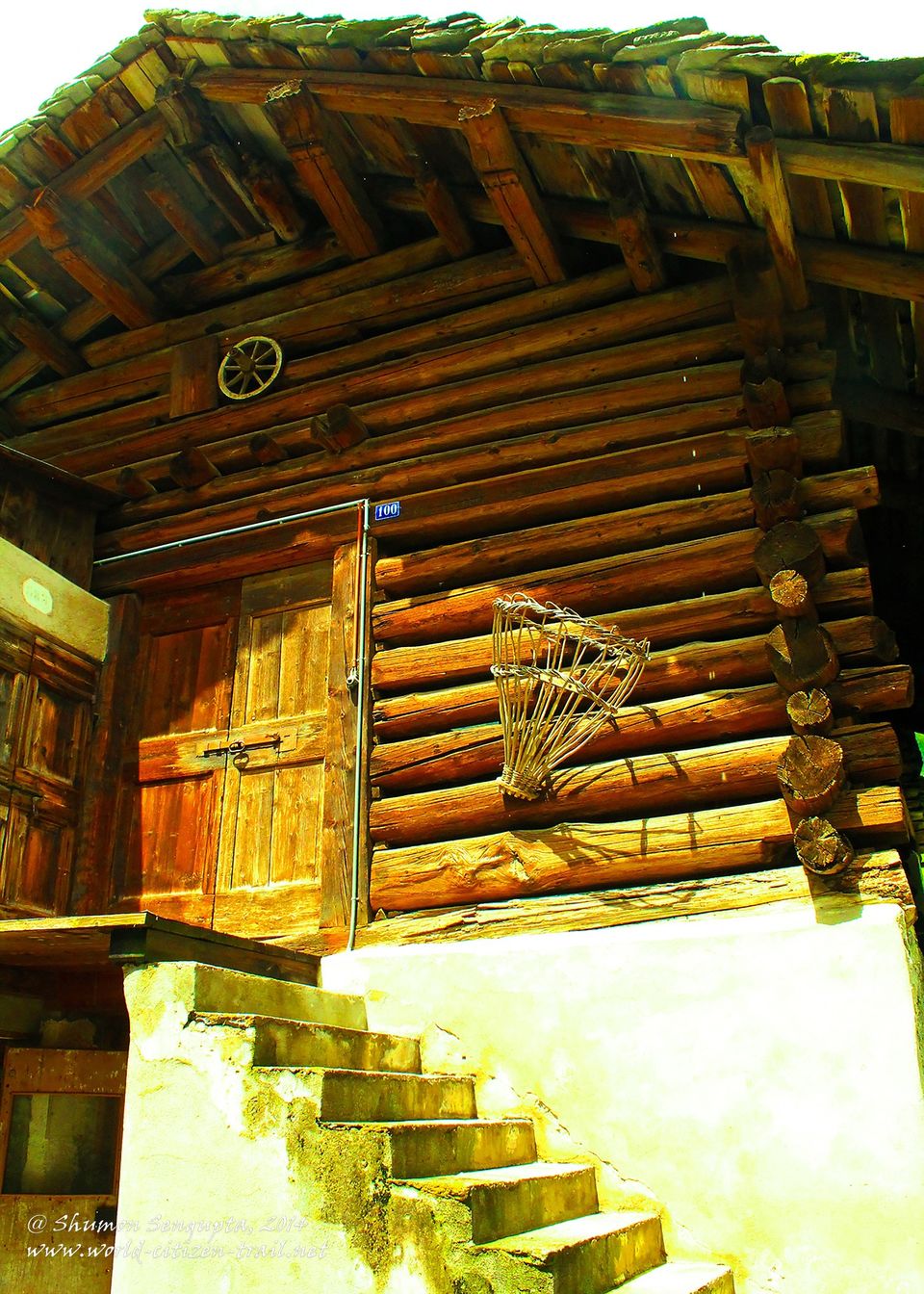
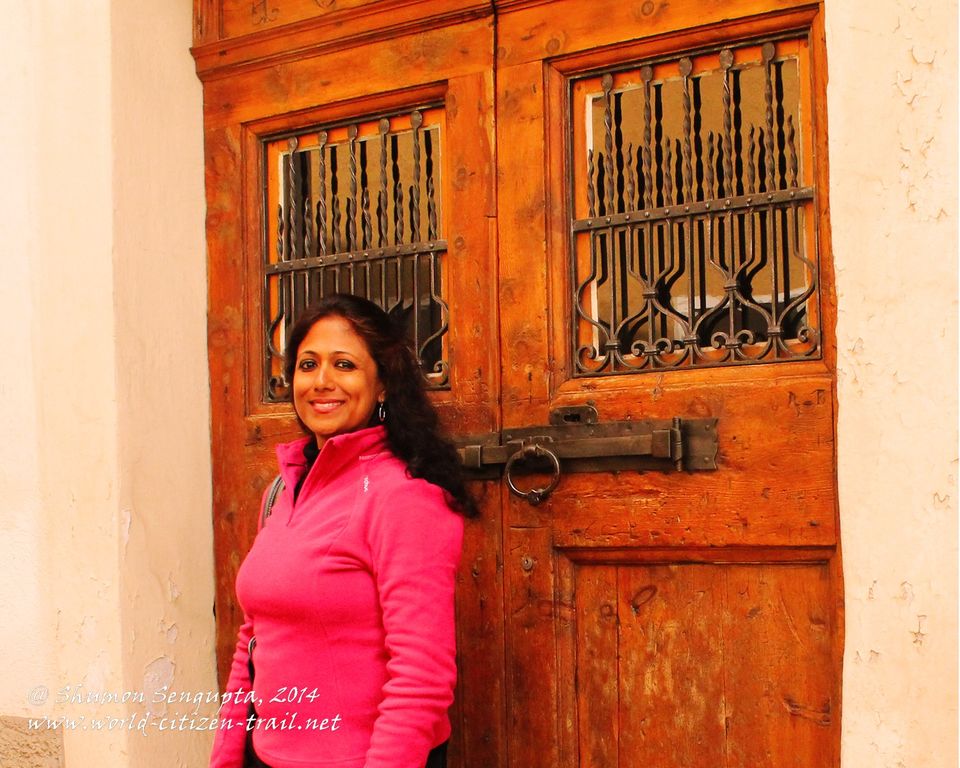
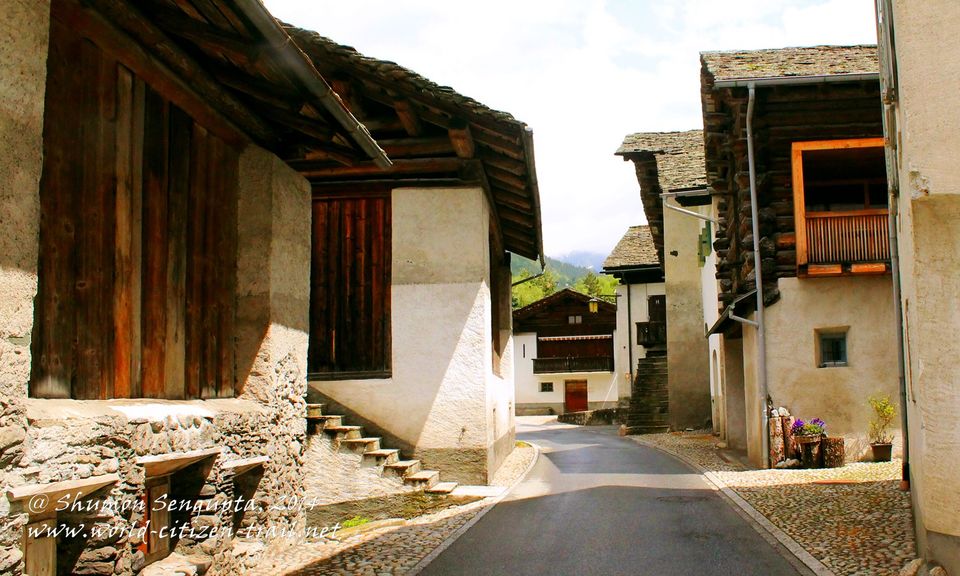
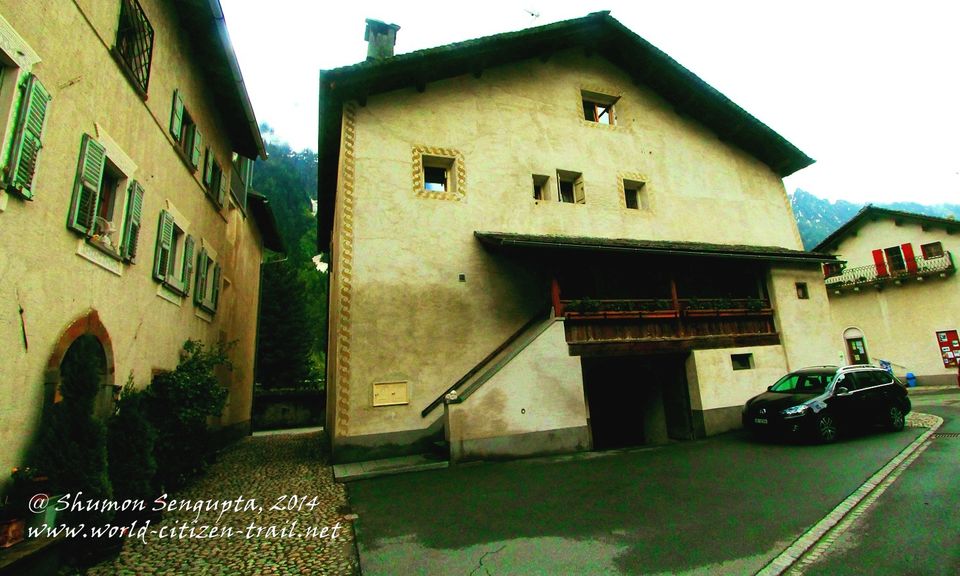
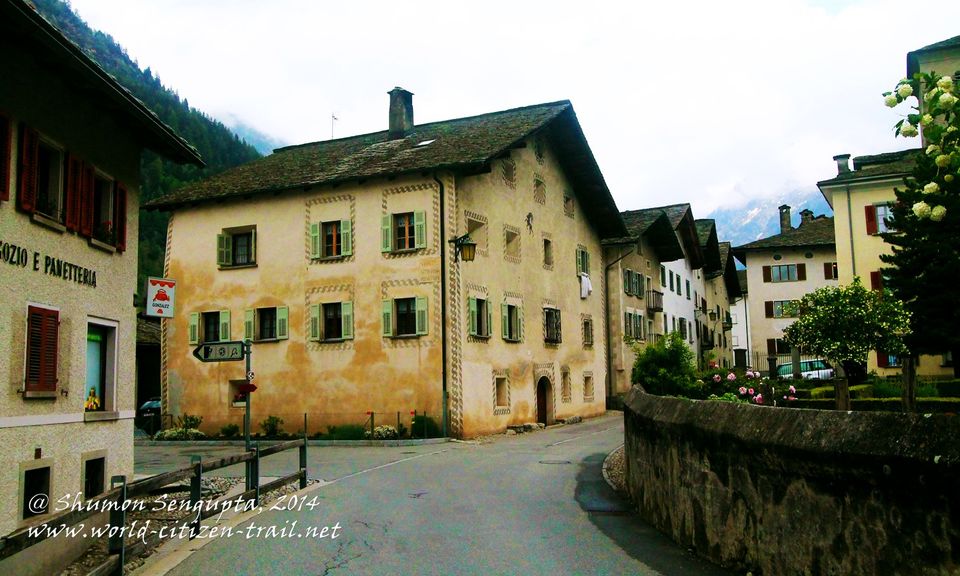
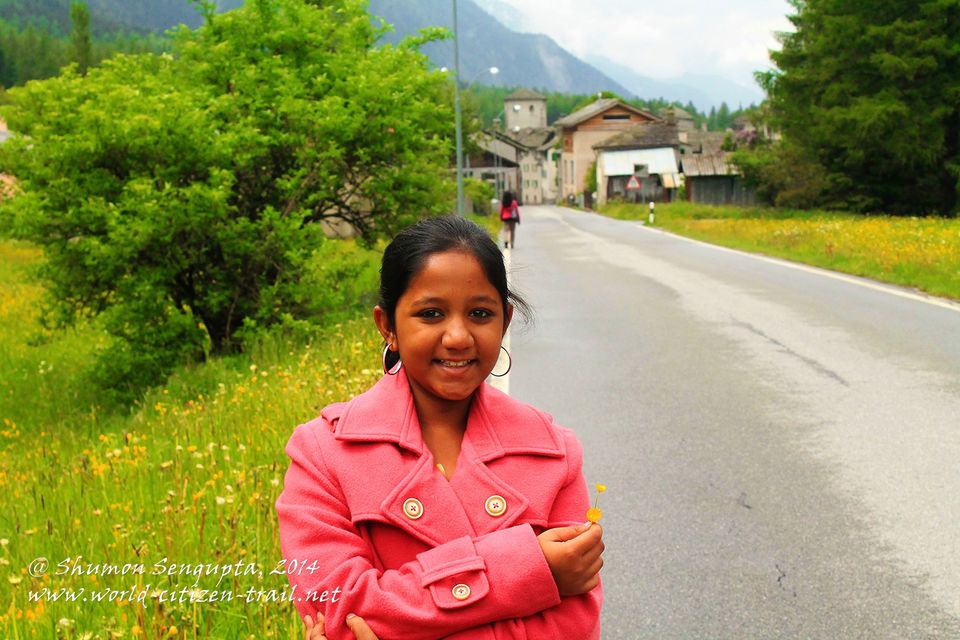
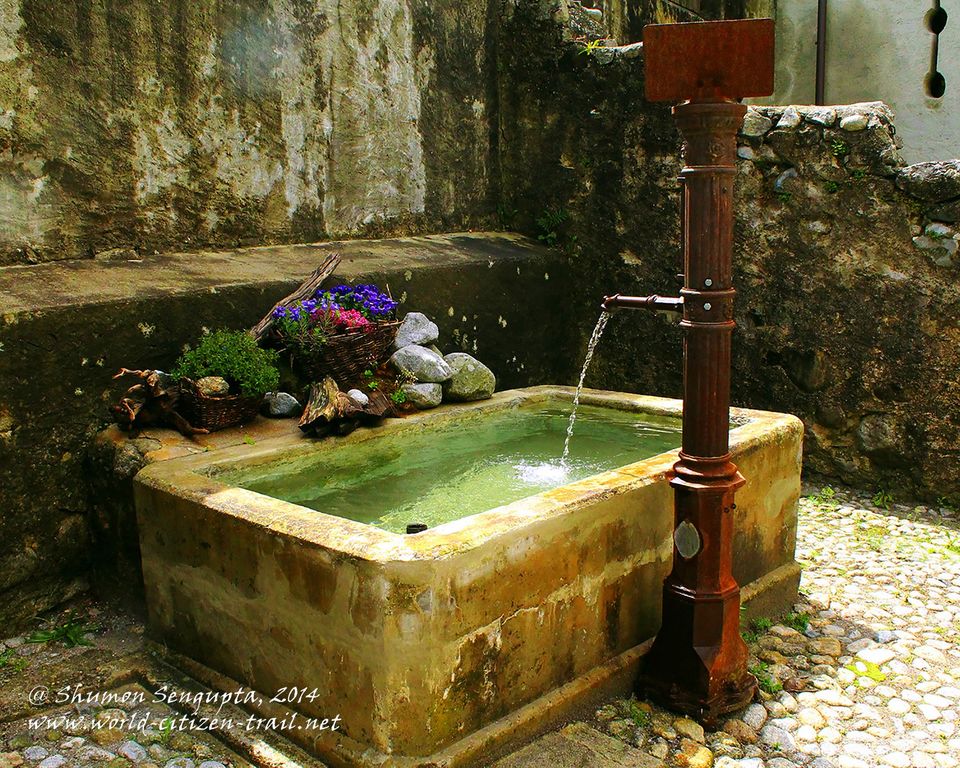
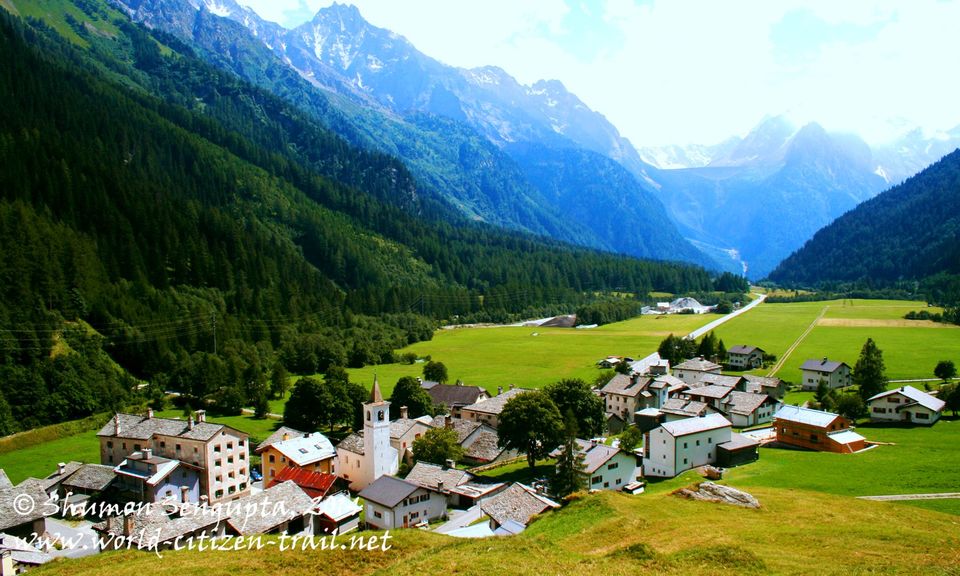
We spent five days in the Eastern and Southeastern part of Switzerland, in the canton of Graubunden. This Canton has vast expanses of pristine countryside dotted by small villages of unsurpassed beauty and character, where vestiges of ancient rural tradition and ways of life continue to this day.
Using St. Moritz as our base location, we explored parts of the Lower Engadine valley northeast of St. Moritz, and then the Bregaglia valley to the south.
In my previous posts, I have described in some detail our trips to the amazing villages of Guarda and Ardez in the Lower Engadine Valley. In this post, I will take up the beautiful and rather curious (you will soon learn why) Vicosoprano village and briefly before that, our visit to a farm that makes artisanal cheese.
The way to the Bragaglia Valley from St. Moritz is via the Maloja pass. There is no rail service to this part of the country, but the Post Bus runs at frequent and regular intervals throughout the day, from St. Moritz.
After an early breakfast, we set off from St. Moritz for Vicosoprano. We headed south-west, rising steadily, going past the village resorts of Silvaplana and Sils and the chain of four connected glacial lakes – crystal clear and shimmering, fringed by lofty snow-clad Alps – on to the spectacular Maloja pass.
Situated 5,941 feet above sea level, the stark exposed plateau of Maloja is surrounded by bare jagged mountains. From the Maloja pass we made a sudden descent and then taking a sharp turn along a cliff edge, went through a series of switchbacks (zig-zags roads) down the mountain, to make a steep descent of 1000 feet into the Italian speaking Val Bregaglia. It was a dramatic decent indeed!
It was then that we noticed the changes. The chill in the air that we had felt earlier in St. Moritz was gone, and the vegetation had become dense, diverse, deep and lush. And instead of the large fashionably elegant houses seen earlier, we found modest cottages made or stone, wood and slated roofs. The mountains too had changed. The lower reaches were forested, and the upper reaches seemed less snowy than earlier; they were rockier, weathered, jagged and rugged, with sheer, smooth faces, deep ridges, and soaring buttresses.
We had boarded our bus at 9:08 am and by 10.05 am we were at Vicosoprano Camping, a beautiful thickly carpeted meadow, surrounded by soaring, uneven, rugged peaks. From there we took a narrow road that branched off and curved to the right, through a thickly wooded area, towards the Pungel village, to visit a cheese farm. We walked for a little (around 200 meters) slightly uphill and then over a bridge under which the waters flowed in violent gushes, roaring and foaming. The cheese farm, owned by the cheese making Perdoni family, was located just after the bridge. The sign in front of the farm on the road read “Zu verkaufen Käse, Milch und Eier” (Cheese, milk and eggs for sale).
In the Bregaglia valley, there quite a few varieties of delicious cheeses made from cow and goat milk. There is young cheese, soft and mild, as well as aged cheese, hard and sharper in taste. The cheese is certified as organic.
At the Peredoni farm, Master Cheesemaker, Mr. Perdoni showed us how predominantly handmade/artisanal cheese is made in small scale (unlike the industrial scale cheese factory we saw in Gruyeres). And then Mr. Massimo, the affable young assistant of Mr. Perdoni took us around the farm and showed us different breeds of cows. After the end of the tour, we tasted some cheese of different ages and then headed back towards the village of Vicosoprano by the Cadalpena Street.
After about 20 minutes of walking, we were in the Vicosoprano village.
Surrounded by meadows and forests, the village is located at an altitude of 3,566 feet. It is also a convenient center for walks, hikes, and treks into the valley and has a few hotels, pensions and restaurants. In the past, Vicosoprano was the capital of the valley and today, it is the largest village of Bregaglia. On the upper right-hand side of the village, an ancient Roman settlement has been revealed following excavated. The history of human settlement in this village, therefore, goes a long way back. Also, the history of the village is at once grand and sinister (and you shall soon know why).
The original main street leading to the village is no longer used as the bus route from St. Moritz. Instead, now the bus route bypasses the village, rendering the village tranquil and devoid of large vehicles. This made our leisurely stroll through the village particularly pleasant and charming.
Further ahead, after we entered the village and passed by a few beautiful houses and a fountain, we took a sharp right and immediate left turn on the same street, to end up in a small square. There we found another old stone fountain to our left and the ‘Pretorio’ (or ‘Pretorium’) to our right.
Built in 1583, the Pretorio, with its attached round tower/rotunda was the building that housed the court, as well as customs and municipal offices in the medieval times. Many legal proceedings were held here during those times. Now it is a museum, open to visitors.
Now, before I tell you more about the ‘Pretorio,' a brief history would be in order.
During the Middle Ages, Vicosoprano had played a vital role in the valley, regarding trade, commerce and politics because of its preeminent location close to the trading routes over the nearby Maloja and September passes. It thus gained an influential and prosperous position in the region. It was the capital, hosting the Bregaglia high court, bailiff and the Sheriff.
The beauty, peace, and tranquility of present day Vicosoprano, however, belies its turbulent history.
The Engadine and Bragaglia valleys in the canton of Graubunden had witnessed a conflict (called the ‘Bündner Wirren’ or commonly ‘Graubunden Roits’) that lasted from 1618 to 1639. This was a conflict between a political alliance of France and Venice against the Spanish-Austrian Habsburg Monarchy, played out in Graubunden. The Protestants were supported by France and Venice while the Catholics were supported by the Habsburgs in Spain and Austria. Each side sought to gain control of the Graubünden to gain control over the important alpine passes and by the end of the conflict, the Protestants were decimated and practically banned in the valley.
During this long conflict, several plots, intrigues and conspiracies were hatched in Vicosoprano; it was a hotbed of civil strife and public disorder. And then, there was a dark and sinister side too.
From the late 15th century to the late 18th century, there was a widespread fear of witchcraft in Europe, which led to a spate of persecution of innocent people. Tens of thousands of people, mainly women, were executed for alleged witchcraft. Those accused of witchcraft were tortured until they ‘confessed’. Obviously, if one is tortured, one would probably ‘confess’ to anything in an attempt to end their agony. And then when someone made a forced confession to escape torture, they would be executed.
In the 15th century, most of the trials involved independent-minded, freethinking men who refused to submit to the religious or political authorities. However in the 16th and 17th centuries, once secular power was well established, accusations of witchcraft were used by the authorities to regulate law and order and impose social discipline, and victims became largely women. In a loosely federated patch-work State like Switzerland, which did not have a strong central political and administrative authority, local authorities in the regions used witchcraft trials as a tool of fear and intimidation to assert their power and maintain their grip on the population.
In the 17th century, over 3,500 people, mainly women, were executed in the French-speaking area of Switzerland, reportedly more than anywhere else in Europe per head of population. And Vicosoprano had its share of executions in the Italian-speaking part of the country.
Vicosoprano was a place where innocent women who often fell out of favor of powerful men were accused as witches, tortured, tried and executed. The Pretorio was the building in which these sinister and sham witch trials were held, during which confessions were extracted by extreme torture. The Vicosoprano witch trials began in the second half of the 17th century, and more than twenty alleged witches were executed – hanged or burned at the stake.
Earlier I had mentioned that Vicosoprano is a curious village. Now you know why.
We spent some time in the plaza and drank some fresh cold water from the fountain and admired the beautiful old, well-maintained buildings around us. We then decided to check the Pretorio out.
On either side on the façade, above the arched entrance gate to the Pretorio were the two allegories (visual symbols) of justice and temperance etched on the plaster using the ‘Sagraffito’ mural technique (described at length in my posts on Ardez and Guarda). These two murals date back to 1583.
Temperance (or self-control), one of the four Cardinal Virtues in Christianity, is allegorically depicted here as a woman pouring water into wine, ostensibly tempering the quantity of intoxicating alcohol. Justice is allegorically depicted, again as the woman, with the scales of justice in one hand and a sword in the other.
On the right side of the Pretorio was the old medieval pillory (punishment post) – in this case a high stone block where a petty offender would, in days bygone, be bound with an iron collar around the neck in full public view, for whipping and debasement by the public. The iron neck collar still hangs from the wall grimly.The Pretorio building has two attached sections – the town hall built in 1583 and the much older rotunda (or the round tower), which was built in the 13th century. The rotunda was converted into jail when the town hall was built, and one can access the rotunda from inside the town hall.
As we entered the Pretorio (there is a small museum inside), the heavy walls, dim lights, and the uneven, cold stone floor gave us an eerie feeling. To our left was a large colorful mural, depicting the inglorious period of witch hunting and burning. It depicted the cruelty of the oppressors and the horror and agony of the victims powerfully.We then toured rest of the building – the wood-paneled courtroom (where the trial of the witches had taken place), prison and the torture chamber and this gave us a creepy feeling. In fact, the modern lighting and sound system inside the Pretorio have been designed to create a spine-chilling experience.
We saw the place where confessions were extracted from innocent women alleged as witches, using extreme forms of torture. We also saw hanging a noose. And then we went to the top to get an amazing view of the village. Finally, at the edge of the village were the stakes where the alleged witches were burnt. The Pretorio was supposed to embody justice and temperance, and we realized that it was anything but that. It served to alert us to our humanity, rather the lack of it.
We recovered from our tour of the Pretorio by walking through the quaint, picturesque village. We continued along the street through the heart of the village, past charming old houses. Some of the houses were grand and aristocratic, with hanging wooden and wrought iron balconies and beautiful ‘sgraffito’ murals (described in detail in my posts on Guarda and Ardez).
One of the ‘Sgraffito’ inscriptions thus reads (in mixed Italian and German) – “There is no man on this earth who does not have a touch of madness”. I felt reassured.
We also went past the St. Trinity Church next to the plaza (or piazza in Italian). Being a reformed/protestant church, the architecture of the St. Trinity Church and its interiors are simple and restrained, without much ornamentation. The carved wooden pulpit in the florid rococo style is beautiful, as is the sacrament table made of colored marble stone.
From there we proceeded to the arched stone bridge and saw magnificent views of the mountains on either side. The much older church of St. Cassiano (dating back to 1355, reconstructed in 1491 and renovated in 1864) is across the river at a slightly elevated position. It is no longer in use; I was told.
Getting back to the Plazza, we boarded the bus that took us to Soglio (covered in the next post) through Stampa and Promontogno. Our visit to the beautiful village of Vicosoprano, cradled by mountains and forests, was a wonderful and sobering experience by all means.
Travelling tips:
1. Foods to try: For those of you who love your meat, the specialties (I am so told) are salami, venison salametti, various cured meats, particularly the Bundnerfliesch (air-dried meat). You may get them at the Chiesa Family Butcher, a family that has been producing these specialties for over half a century in Vicosoprano.
For vegetarians like me, there is a range of cheese (including Goat cheese), but please be aware that the cheese may be produced using rennet, an animal product.
Since this place has vast chestnut grooves, it is also famous for a wide range of chestnut specialties such as chestnut ravioli (ideal for vegetarians), pasta and gnocchi made of chestnut flour, chestnut jam, chestnut cookies, chestnut cake and even chestnut flake cereal.
2. Getting there: There are buses leaving from St. Moritz to Vicosoprano Plazza every 40 minutes, via the resort villages of Silvaplana and Sils and through the Maloja pass.
The road descends dramatically from the Maloja pass, and there are a series of switchback roads and loops. If you have a problem with motion sickness (as I do), don’t forget to pop in an anti-emetic half an hour before you take the bus from St. Moritz.
In case you are doing only Viccosporano and you start early enough, you might get off at Maloja and spend a couple of hours there taking in the views. There are many beautiful picnic spots there. And just outside Maloja, in Pila, there is a beautiful waterfall of the Inn River.
If you are planning to do Soglio as well on the same day (you may want to see my post on that), head straight to Vicosoprano, and if you don’t break your journey in Maloja, you will be in Vicosoprano from St. Moritz in an hour.
3. Between April and October, the Pretorio and the rotunda are open daily. Guided tours are also available. You need to call and make an appointment. On the guided tour, you will also learn about the culture and local traditions of the Bregaglia Valley.
4. If you plan to go the Pungel to see handmade cheese being made, you need to get off at Vicosoprano Camping (the stop before Vicosoprano Plaza) and walk to the Pungel village by the road to your right, immediately after the Vicosoprano Camping bus stop. It is a lovely 20-25 minute walk through a small forest and over a bridge with a gushing river underneath. From the Pungel village, it is another 20-25 minute amazing walk over a flat road on the floor of the valley.
5. Other options in and around Vicosoprano:
There are plenty of amazing options for hiking, walking and cycling into the Albigna region, from Vicosoprano. There are beautiful trails leading to the hamlets of Roticcio and Pungel, and there is a great campsite near Vicosoprano called Vicosoprano Camping. It is a dream destination for those of you who love camping and the outdoor life. The campsite has great picnic benches, undercover areas for cooking and eating, fire pits, barbecues and a good supply of free wood from the timber yard. Close to the camping site is a small lake or pond with rafts for children to play. So if you are an outdoor person, love camping and have the time (which we didn’t) go for a night and day at this camp.
Between Vicosoprano and Soglio is a beautiful little village called Stampa, the birthplace of the painter Augusto Giacometti and his son, the sculptor Alberto Giacometti. So if you want to pay your tributes to the artists, head for Stampa.
6. The shop “Artigianale Bregaglia,” (Bregaglia Handicrafts) offers visitors the opportunity to buy locally handmade crafts such as wooden toys, dolls, lamps, dishes, kitchen utensils, sweaters and dresses for children, blankets – everything beautiful, elegant and simple.
This trip was originally published on Tales from the Trail of a World Citizen





